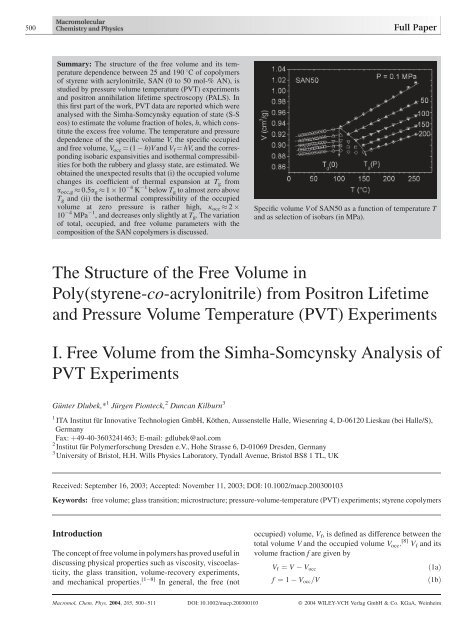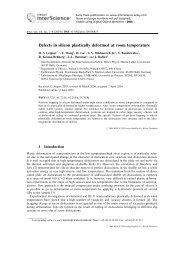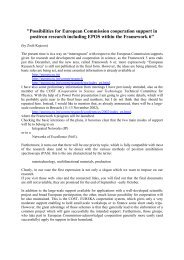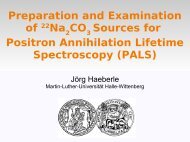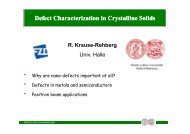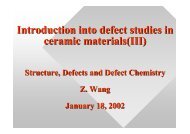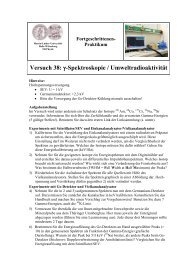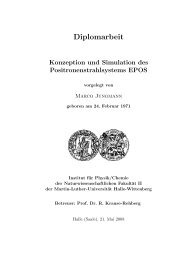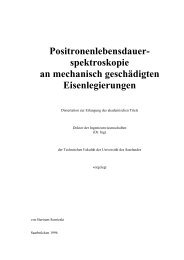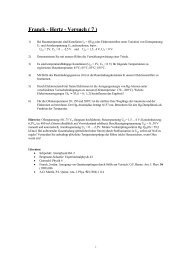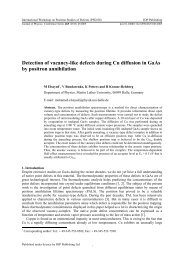The Structure of the Free Volume in Poly(styrene-co-acrylonitrile ...
The Structure of the Free Volume in Poly(styrene-co-acrylonitrile ...
The Structure of the Free Volume in Poly(styrene-co-acrylonitrile ...
Create successful ePaper yourself
Turn your PDF publications into a flip-book with our unique Google optimized e-Paper software.
500 Full Paper<br />
Summary: <strong>The</strong> structure <strong>of</strong> <strong>the</strong> free volume and its temperature<br />
dependence between 25 and 190 8C <strong>of</strong> <strong>co</strong>polymers<br />
<strong>of</strong> <strong>styrene</strong> with <strong>acrylonitrile</strong>, SAN (0 to 50 mol-% AN), is<br />
studied by pressure volume temperature (PVT) experiments<br />
and positron annihilation lifetime spectros<strong>co</strong>py (PALS). In<br />
this first part <strong>of</strong> <strong>the</strong> work, PVT data are reported which were<br />
analysed with <strong>the</strong> Simha-Somcynsky equation <strong>of</strong> state (S-S<br />
eos) to estimate <strong>the</strong> volume fraction <strong>of</strong> holes, h, which <strong>co</strong>nstitute<br />
<strong>the</strong> excess free volume. <strong>The</strong> temperature and pressure<br />
dependence <strong>of</strong> <strong>the</strong> specific volume V, <strong>the</strong> specific occupied<br />
and free volume, V occ ¼ (1 h)Vand V f ¼ hV, and <strong>the</strong> <strong>co</strong>rrespond<strong>in</strong>g<br />
isobaric expansivities and iso<strong>the</strong>rmal <strong>co</strong>mpressibilities<br />
for both <strong>the</strong> rubbery and glassy state, are estimated. We<br />
obta<strong>in</strong>ed <strong>the</strong> unexpected results that (i) <strong>the</strong> occupied volume<br />
changes its <strong>co</strong>efficient <strong>of</strong> <strong>the</strong>rmal expansion at T g from<br />
a occ,g 0.5a g 1 10 4 K 1 below T g to almost zero above<br />
T g and (ii) <strong>the</strong> iso<strong>the</strong>rmal <strong>co</strong>mpressibility <strong>of</strong> <strong>the</strong> occupied<br />
volume at zero pressure is ra<strong>the</strong>r high, kocc 2<br />
10 4 MPa 1 , and decreases only slightly at T g. <strong>The</strong> variation<br />
<strong>of</strong> total, occupied, and free volume parameters with <strong>the</strong><br />
<strong>co</strong>mposition <strong>of</strong> <strong>the</strong> SAN <strong>co</strong>polymers is discussed.<br />
<strong>The</strong> <strong>Structure</strong> <strong>of</strong> <strong>the</strong> <strong>Free</strong> <strong>Volume</strong> <strong>in</strong><br />
<strong>Poly</strong>(<strong>styrene</strong>-<strong>co</strong>-<strong>acrylonitrile</strong>) from Positron Lifetime<br />
and Pressure <strong>Volume</strong> Temperature (PVT) Experiments<br />
I. <strong>Free</strong> <strong>Volume</strong> from <strong>the</strong> Simha-Somcynsky Analysis <strong>of</strong><br />
PVT Experiments<br />
Günter Dlubek,* 1 Jürgen Pionteck, 2 Duncan Kilburn 3<br />
1<br />
ITA Institut für Innovative Technologien GmbH, Kö<strong>the</strong>n, Aussenstelle Halle, Wiesenr<strong>in</strong>g 4, D-06120 Lieskau (bei Halle/S),<br />
Germany<br />
Fax: þ49-40-3603241463; E-mail: gdlubek@aol.<strong>co</strong>m<br />
2<br />
Institut für <strong>Poly</strong>merforschung Dresden e.V., Hohe Strasse 6, D-01069 Dresden, Germany<br />
3<br />
University <strong>of</strong> Bristol, H.H. Wills Physics Laboratory, Tyndall Avenue, Bristol BS8 1 TL, UK<br />
Received: September 16, 2003; Accepted: November 11, 2003; DOI: 10.1002/macp.200300103<br />
Keywords: free volume; glass transition; microstructure; pressure-volume-temperature (PVT) experiments; <strong>styrene</strong> <strong>co</strong>polymers<br />
Introduction<br />
<strong>The</strong> <strong>co</strong>ncept <strong>of</strong> free volume <strong>in</strong> polymers has proved useful <strong>in</strong><br />
discuss<strong>in</strong>g physical properties such as vis<strong>co</strong>sity, vis<strong>co</strong>elasticity,<br />
<strong>the</strong> glass transition, volume-re<strong>co</strong>very experiments,<br />
and mechanical properties. [1–8] In general, <strong>the</strong> free (not<br />
Specific volume V <strong>of</strong> SAN50 as a function <strong>of</strong> temperature T<br />
and as selection <strong>of</strong> isobars (<strong>in</strong> MPa).<br />
occupied) volume, V f, is def<strong>in</strong>ed as difference between <strong>the</strong><br />
total volume V and <strong>the</strong> occupied volume Vocc. [8] Vf and its<br />
volume fraction f are given by<br />
Vf ¼ V Vocc ð1aÞ<br />
f ¼ 1 Vocc=V ð1bÞ<br />
Macromol. Chem. Phys. 2004, 205, 500–511 DOI: 10.1002/macp.200300103 ß 2004 WILEY-VCH Verlag GmbH & Co. KGaA, We<strong>in</strong>heim
<strong>The</strong> <strong>Structure</strong> <strong>of</strong> <strong>the</strong> <strong>Free</strong> <strong>Volume</strong> <strong>in</strong> <strong>Poly</strong>(<strong>styrene</strong>-<strong>co</strong>-<strong>acrylonitrile</strong>) from Positron Lifetime ... 501<br />
However, no unambiguous def<strong>in</strong>ition <strong>of</strong> <strong>the</strong> occupied<br />
volume is available. Due to this, very different values for Vf<br />
and f and sometimes mislead<strong>in</strong>g <strong>co</strong>nclusion can be found <strong>in</strong><br />
<strong>the</strong> literature.<br />
<strong>The</strong> simplest and most clear way is to identify V occ with<br />
<strong>the</strong> van der Waals volume V W, that is <strong>the</strong> space occupied by a<br />
molecule, which is impenetrable to o<strong>the</strong>r molecules with<br />
normal <strong>the</strong>rmal energies. [8,9] VW can be calculated us<strong>in</strong>g <strong>the</strong><br />
group <strong>co</strong>ntribution method developed by Bondi. [10,11] In<br />
this case Vf : VfW and fW ¼ 1 VW/V represents <strong>the</strong> total<br />
(van der Waals) free volume or empty space. This type <strong>of</strong><br />
empty space is well known <strong>in</strong> polymer crystals where it is<br />
frequently termed <strong>in</strong>terstitial free volume, [8] V c ¼ V W þ V fi.<br />
It has values typically somewhat larger than 1 C hdp ¼<br />
0.26 where C hdp ¼ 0.74 is <strong>the</strong> pack<strong>in</strong>g <strong>co</strong>efficient <strong>of</strong> <strong>the</strong><br />
most dense pack<strong>in</strong>g <strong>of</strong> hard spheres (hdp or fcc lattice) [11]<br />
and expands with <strong>the</strong> temperature due to <strong>the</strong> anharmonicity<br />
<strong>of</strong> molecular vibrations.<br />
Amorphous polymers <strong>co</strong>nta<strong>in</strong> an additional free volume<br />
which lowers <strong>the</strong> density by about 10% <strong>co</strong>mpared with<br />
<strong>the</strong> crystall<strong>in</strong>e state <strong>of</strong> <strong>the</strong> same material. [11] This excess<br />
free volume appears <strong>in</strong> form <strong>of</strong> many irregularly shaped<br />
cavities or holes <strong>of</strong> atomic and molecular dimension (local<br />
free volumes) which arise because <strong>of</strong> disordered molecular<br />
pack<strong>in</strong>g <strong>in</strong> <strong>the</strong> amorphous phase (static and pre-exist<strong>in</strong>g<br />
holes), and molecular relaxation among <strong>the</strong> molecular<br />
cha<strong>in</strong>s and term<strong>in</strong>al ends (dynamic and transient holes). <strong>The</strong><br />
diffusion <strong>of</strong> small molecules through glassy polymers and<br />
<strong>the</strong> dynamics <strong>of</strong> rubbery polymers, as observed <strong>in</strong> mechanical<br />
or dielectrical relaxation and <strong>in</strong> vis<strong>co</strong>sity experiments,<br />
[1–6] are related to this type <strong>of</strong> (excess or hole) free<br />
volume. For calculat<strong>in</strong>g <strong>the</strong> hole free volume, Vf : Vfh ¼<br />
V Vocc, fh ¼ 1 Vocc/V, various approximations <strong>of</strong> <strong>the</strong><br />
occupied volume, Vocc, which now <strong>in</strong>cludes <strong>the</strong> <strong>in</strong>terstitial<br />
free volume, Vocc ¼ VW þ Vfi, fi ¼ 1 Vfi/V, are used. <strong>The</strong><br />
total (van der Waals) free volume is given by VfW ¼ Vfi þ<br />
V fh, <strong>the</strong> <strong>co</strong>rrespond<strong>in</strong>g fractional free volume by<br />
f W ¼ f i þ f h. Follow<strong>in</strong>g <strong>the</strong> traditional term<strong>in</strong>ology we will<br />
use <strong>in</strong> <strong>the</strong> follow<strong>in</strong>g paragraphs <strong>the</strong> symbols V f (:V fh) and<br />
f (:fh) to describe <strong>the</strong> (excess) hole free volume and its<br />
volume fraction and VfWand fW for <strong>the</strong> total, van der Waals,<br />
free volume. Most <strong>co</strong>mmon approximations <strong>of</strong> <strong>the</strong> occupied<br />
volume are <strong>the</strong> zero po<strong>in</strong>t volume estimated from <strong>the</strong><br />
extrapolation <strong>of</strong> <strong>the</strong> densities <strong>of</strong> crystall<strong>in</strong>e or liquid<br />
(rubbery) materials down to 0 K, [1,2,10–12] V occ(0) ¼<br />
V r(0) ¼ V c(0) 1.3 V W, [10,11] and <strong>the</strong> crystall<strong>in</strong>e volume<br />
at room temperature, V occ(25 8C) ¼ V c(25 8C)<br />
1.45 VW. [11,13,14]<br />
Due to <strong>the</strong> anharmonicity <strong>of</strong> molecular vibrations <strong>the</strong><br />
occupied volume will show a <strong>the</strong>rmal expansion with a<br />
<strong>co</strong>efficient aocc, Vocc(T) ¼ Vocc(0)(1 þ aoccT). S<strong>in</strong>ce aocc is<br />
usually unknown, it is standard to identify it with <strong>the</strong><br />
<strong>co</strong>efficient <strong>of</strong> <strong>the</strong>rmal expansion <strong>of</strong> <strong>the</strong> glassy state, a occ ¼<br />
a g. [12] From this follows a frequently used relation for <strong>the</strong><br />
calculation <strong>of</strong> <strong>the</strong> temperature dependence <strong>of</strong> <strong>the</strong> fractional<br />
excess (hole) free volume above Tg:<br />
f ðTÞ ¼fg þ afr *ðT TgÞ ð2aÞ<br />
afr * Da ¼ ar ag ð2bÞ<br />
where fg is <strong>the</strong> fractional excess free volume at Tg and<br />
a fr* ¼ (1/V) (dV f/dT) ¼ (1/V) [d(V V occ)/dT] is <strong>the</strong> fractional<br />
<strong>co</strong>efficient <strong>of</strong> <strong>the</strong>rmal expansion <strong>of</strong> <strong>the</strong> excess free<br />
volume <strong>in</strong> <strong>the</strong> rubbery state <strong>of</strong> <strong>the</strong> polymer. a fr* is usually<br />
approximated by <strong>the</strong> difference <strong>of</strong> <strong>the</strong> <strong>co</strong>efficients <strong>of</strong><br />
<strong>the</strong>rmal volume expansion <strong>in</strong> <strong>the</strong> rubbery and glassy<br />
states, afr* ¼ Da ¼ (ar ag). [12] William, Landel, and Ferry<br />
(WLF) [3] estimated from vis<strong>co</strong>sity data values <strong>of</strong> Da ¼<br />
4.8 10 4 K 1 and fg ¼ 0.025 (WLF equation with B ¼ 1)<br />
which were believed for a long time to be universal.<br />
Later [15] it was found, however, that <strong>the</strong> hole fraction<br />
<strong>in</strong>creases from f g 0.02 for polymers with T g ¼ 200 K to<br />
fg 0.08 for polymers with Tg ¼ 400 K, a results which was<br />
<strong>co</strong>nfirmed recently. [16] From this result it was <strong>co</strong>ncluded<br />
that <strong>the</strong> glass transition is not an iso-free volume transition<br />
but ra<strong>the</strong>r determ<strong>in</strong>ed by <strong>the</strong> structural relaxation time<br />
(tg 100 s).<br />
A method which proved to be very successful <strong>in</strong> estimation<br />
<strong>of</strong> <strong>the</strong> fraction <strong>of</strong> free volume holes is <strong>the</strong> analysis <strong>of</strong><br />
pressure volume temperature (PVT) experiments us<strong>in</strong>g <strong>the</strong><br />
Simha-Somcynsky hole <strong>the</strong>ory equation <strong>of</strong> state (S-S<br />
eos). [15,17–19] This <strong>the</strong>ory describes <strong>the</strong> structure <strong>of</strong> a liquid<br />
by a cell or lattice model which allows an occupied latticesite<br />
fraction y ¼ y(V, T) <strong>of</strong> less <strong>the</strong>n one. <strong>The</strong> volume <strong>of</strong> an<br />
occupied lattice-site <strong>co</strong>nta<strong>in</strong>s <strong>the</strong> van der Waals volume <strong>of</strong><br />
<strong>the</strong> mer and a free volume <strong>in</strong>herent to <strong>the</strong> lattice cell. <strong>The</strong><br />
latter can be imag<strong>in</strong>ed to be similar to <strong>the</strong> <strong>in</strong>terstitial free<br />
volume <strong>of</strong> an elementary cell <strong>in</strong> crystals. In atomistic<br />
modell<strong>in</strong>g it has its <strong>co</strong>rrespondence <strong>in</strong> a large number <strong>of</strong><br />
holes be<strong>in</strong>g too small to <strong>co</strong>ntribute essentially to <strong>the</strong><br />
transport <strong>of</strong> small molecules, for example. It is assumed that<br />
N molecules, <strong>co</strong>nsist<strong>in</strong>g <strong>of</strong> n chemical repeat<strong>in</strong>g units, nmers,<br />
with molecular weight Mrep, are divided <strong>in</strong>to s<br />
equivalent segments, s-mers, with molecular weight M 0,<br />
sM 0 ¼ nM rep. <strong>The</strong> number N <strong>of</strong> s-mer molecules occupy<br />
<strong>the</strong> fraction y ¼ sN/(sN þ N h SS ) <strong>of</strong> <strong>the</strong> total available sites,<br />
(sN þ Nh SS ), where Nh SS is <strong>the</strong> number <strong>of</strong> unoccupied lattice<br />
sites or holes <strong>of</strong> <strong>the</strong> S-S <strong>the</strong>ory. <strong>The</strong> excess free-volume<br />
fraction is given by <strong>the</strong> fraction <strong>of</strong> unoccupied lattice-sites<br />
(holes) which is denoted <strong>in</strong> this <strong>the</strong>ory by h, h(V, T) ¼ 1 y.<br />
<strong>The</strong> h <strong>of</strong> <strong>the</strong> S-S eos <strong>co</strong>rresponds to our def<strong>in</strong>ition <strong>of</strong> f, f : h;<br />
<strong>in</strong> this paper we will use both symbols synonymously. <strong>The</strong><br />
macros<strong>co</strong>pic volume expands ma<strong>in</strong>ly due to <strong>the</strong> formation<br />
<strong>of</strong> new empty lattice sites.<br />
<strong>The</strong> S-S <strong>the</strong>ory expresses <strong>the</strong> <strong>co</strong>nfigurational or Helmholtz<br />
free energy F <strong>in</strong> terms <strong>of</strong> <strong>the</strong> volume V, temperature T<br />
and occupied lattice-site fraction y ¼ y(V, T), F ¼ F(V, T, y).<br />
<strong>The</strong> value <strong>of</strong> y is obta<strong>in</strong>ed through <strong>the</strong> pressure equation<br />
P ¼ (@F/@V)T and <strong>the</strong> m<strong>in</strong>imisation <strong>co</strong>ndition (@F/<br />
@y) V,T ¼ 0. <strong>The</strong> S-S eos is <strong>the</strong> most successful <strong>the</strong>ory <strong>in</strong><br />
Macromol. Chem. Phys. 2004, 205, 500–511 www.mcp-journal.de ß 2004 WILEY-VCH Verlag GmbH & Co. KGaA, We<strong>in</strong>heim
502<br />
describ<strong>in</strong>g <strong>the</strong> variation <strong>of</strong> <strong>the</strong> specific volume as function<br />
<strong>of</strong> <strong>the</strong> temperature T and <strong>the</strong> hydrostatic pressure P. Several<br />
universal relationships where found which allow an<br />
approximate estimation <strong>of</strong> h and fW. [9,17–19]<br />
Despite a great deal <strong>of</strong> <strong>in</strong>terest <strong>in</strong> <strong>in</strong>vestigations <strong>of</strong> free<br />
volume <strong>in</strong> polymers, only limited <strong>in</strong>formation about its real<br />
structures, <strong>the</strong> hole dimensions and <strong>the</strong> size and shape<br />
distributions, are available, ma<strong>in</strong>ly due to a lack <strong>of</strong> suitable<br />
probes for open volumes <strong>of</strong> molecular dimensions. Dur<strong>in</strong>g<br />
<strong>the</strong> past decade, positron annihilation lifetime spectros<strong>co</strong>py<br />
(PALS) has developed to be <strong>the</strong> most important method for<br />
study<strong>in</strong>g sub-nanometer size holes <strong>in</strong> polymers. [20–23] In<br />
this technique, positronium <strong>in</strong> its ortho-state, o-Ps, is used<br />
as a probe for local free volumes. o-Ps is formed <strong>in</strong> or<br />
trapped by sub-nanometer size holes that form <strong>the</strong> (excess)<br />
free volume <strong>of</strong> amorphous polymers. Due to <strong>co</strong>llisions with<br />
<strong>the</strong> walls <strong>of</strong> <strong>the</strong> holes, <strong>the</strong> lifetime <strong>of</strong> o-Ps decreases with<br />
decreas<strong>in</strong>g size <strong>of</strong> holes. Assum<strong>in</strong>g spherical holes, <strong>the</strong> hole<br />
size can be calculated from <strong>the</strong> o-Ps lifetime us<strong>in</strong>g a semiempirical<br />
model.<br />
PALS itself is able to measure <strong>the</strong> mean volume <strong>of</strong> <strong>the</strong><br />
holes and, with larger limitations, <strong>the</strong>ir size distribution, [24]<br />
but not directly <strong>the</strong> hole density and <strong>the</strong> hole fraction.<br />
However, a <strong>co</strong>rrelation <strong>of</strong> PALS results with <strong>the</strong> hole free<br />
volume fraction estimated from <strong>the</strong> macros<strong>co</strong>pic volume by<br />
<strong>the</strong> help <strong>of</strong> <strong>the</strong> S-S eos <strong>the</strong>ory allows to estimate <strong>the</strong> hole<br />
density. [25–30] In one <strong>of</strong> our previous works [31] some <strong>of</strong> us<br />
have shown that <strong>in</strong> <strong>the</strong>rmal expansion experiments <strong>the</strong><br />
direct <strong>co</strong>mparison <strong>of</strong> <strong>the</strong> hole volume from PALS with <strong>the</strong><br />
macros<strong>co</strong>pic volume even allows to estimate <strong>the</strong> number<br />
density <strong>of</strong> holes and <strong>the</strong>ir entire volume fraction. In this<br />
way, all parameters <strong>of</strong> hole free volume can be determ<strong>in</strong>ed.<br />
This method has been successfully applied by several<br />
groups. [14,16,29,30] In <strong>the</strong> analysis <strong>of</strong> <strong>the</strong> experiments it is,<br />
however, usually assumed that <strong>the</strong> occupied volume does<br />
not expand. [14,16,29] As <strong>the</strong> <strong>the</strong>rmal expansion <strong>of</strong> crystals<br />
shows [32] this simplification may be too strong.<br />
In order to obta<strong>in</strong> detailed <strong>in</strong>formation on <strong>the</strong> microstructure<br />
<strong>of</strong> <strong>the</strong> free volume <strong>in</strong> glassy and rubbery states <strong>of</strong><br />
polymers, we have studied <strong>in</strong> <strong>the</strong> present work <strong>the</strong> temperature<br />
dependence <strong>of</strong> <strong>the</strong> specific volume, V, by pressurevolume-temperature<br />
(PVT) experiments [33,34] and <strong>of</strong> <strong>the</strong><br />
size <strong>of</strong> local free volumes (holes) by PALS. For this study<br />
we have chosen a series <strong>of</strong> <strong>co</strong>polymers <strong>of</strong> <strong>styrene</strong> (S,<br />
[–CH 2CH(C 6H 5)–]) with <strong>acrylonitrile</strong> (AN, [–CH 2CH-<br />
(CN)–]), SAN, with a <strong>co</strong>ntent <strong>of</strong> AN <strong>co</strong>monomer between<br />
0 and 50 mol-%. <strong>Poly</strong><strong>styrene</strong> (PS) has been frequently<br />
studied <strong>in</strong> <strong>the</strong> literature by PALS, [14,16,26,28] while for SAN<br />
only two papers present<strong>in</strong>g a series <strong>of</strong> room temperature<br />
measurements [28,35] are known to us. SAN is an <strong>in</strong>terest<strong>in</strong>g<br />
system for our study, s<strong>in</strong>ce <strong>the</strong> specific volume <strong>of</strong> <strong>the</strong><br />
<strong>co</strong>polymers change with variation <strong>of</strong> <strong>the</strong> AN <strong>co</strong>ntent while<br />
<strong>the</strong> glass transition temperature, T g, is almost <strong>co</strong>nstant.<br />
Our work is subdivided <strong>in</strong>to two parts. In this part, we<br />
present PVT experiments and determ<strong>in</strong>e from <strong>the</strong>se, us<strong>in</strong>g<br />
<strong>the</strong> S-S eos, [15,17–19] <strong>the</strong> hole fraction h. <strong>The</strong> temperature<br />
dependence <strong>of</strong> <strong>the</strong> specific volume V, <strong>the</strong> specific occupied<br />
and free volume, Vocc ¼ yVand Vf ¼ hV, and <strong>the</strong> <strong>co</strong>rrespond<strong>in</strong>g<br />
isobaric expansivities and iso<strong>the</strong>rmal <strong>co</strong>mpressibilities<br />
for both <strong>the</strong> rubbery and glassy states, are estimated. <strong>The</strong><br />
variation <strong>of</strong> total, occupied and free volume parameters<br />
with <strong>the</strong> <strong>co</strong>mposition <strong>of</strong> <strong>the</strong> SAN <strong>co</strong>polymer will be<br />
discussed. From our data we will <strong>co</strong>nfirm that fg 0.07 >><br />
0.025 for SAN and show that <strong>the</strong> traditional approximation<br />
afr* ¼ Da ¼ ar ag is not <strong>co</strong>rrect.<br />
<strong>The</strong> se<strong>co</strong>nd part <strong>of</strong> <strong>the</strong> work shows measurements <strong>of</strong> <strong>the</strong><br />
local free volume us<strong>in</strong>g PALS. For <strong>the</strong> analysis <strong>of</strong> <strong>the</strong><br />
positron lifetime spectra we used <strong>the</strong> new rout<strong>in</strong>e LT <strong>in</strong> its<br />
latest version 9.0 [36,37] which allows both discrete and log<br />
normal distributed annihilation rates. From <strong>the</strong>se distributions<br />
<strong>the</strong> mean size and <strong>the</strong> size distribution <strong>of</strong> free volume<br />
holes can be calculated. We will also discuss <strong>the</strong> analysed<br />
hole size distribution <strong>in</strong> relation to <strong>the</strong>oretical models<br />
describ<strong>in</strong>g <strong>the</strong> <strong>the</strong>rmal volume fluctuation. From <strong>the</strong> <strong>co</strong>mparison<br />
<strong>of</strong> specific total and free volumes, Vand Vf, with <strong>the</strong><br />
mean hole volume <strong>the</strong> hole number density is estimated.<br />
Moreover, we discuss variations <strong>in</strong> <strong>the</strong> structure <strong>of</strong> <strong>the</strong><br />
free volume (fraction, hole size and number) as a function <strong>of</strong><br />
<strong>the</strong> <strong>co</strong>ntent <strong>of</strong> AN <strong>co</strong>-monomer and temperature. F<strong>in</strong>ally,<br />
we will show relations between <strong>the</strong> bulk modulus and <strong>the</strong><br />
free volume.<br />
Experimental Part<br />
G. Dlubek, J. Pionteck, D. Kilburn<br />
<strong>Poly</strong>(<strong>styrene</strong>-<strong>co</strong>-<strong>acrylonitrile</strong>) (SAN) test samples were provided<br />
by <strong>the</strong> BASF AG Ludwigshafen. <strong>The</strong>ir characteristics are<br />
given<strong>in</strong>Table1.<strong>The</strong>molecularweightsweredeterm<strong>in</strong>edbyGPC<br />
withRI-detector us<strong>in</strong>g PS standards and by GPC <strong>co</strong>upled withan<br />
LALLS-detector. <strong>The</strong> mean values <strong>of</strong> both methods <strong>of</strong> two<br />
measurements each were very similar (deviation <strong>in</strong> M w with<strong>in</strong><br />
3%). <strong>The</strong> <strong>acrylonitrile</strong> <strong>co</strong>-monomer <strong>co</strong>ntent was calculated from<br />
<strong>the</strong> nitrogen <strong>co</strong>ncentration determ<strong>in</strong>ed by elemental analysis by<br />
means <strong>of</strong> an EA1108 (Carlo Erba). <strong>The</strong> standard deviation from<br />
three measurements was with<strong>in</strong> 0.1% (except SAN50: 0.25%).<br />
<strong>The</strong> DSC measurements were performed with a DSC-7 (Perk<strong>in</strong>-<br />
Elmer), PYRIS-s<strong>of</strong>tware, Version 4.01. <strong>The</strong> glass transition<br />
temperaturesT g(half stepmethod) and<strong>the</strong>stepheightsDc p given<br />
<strong>in</strong> Table 1 were determ<strong>in</strong>ed from <strong>the</strong> 2 nd heat<strong>in</strong>g run <strong>of</strong> a circle 1 st<br />
heat, 1 st <strong>co</strong>ol, 2 nd heat with a scan rate <strong>of</strong> þ10/ 80 K m<strong>in</strong> 1 <strong>in</strong><br />
<strong>the</strong> temperature range <strong>of</strong> 10 to 200 8C.<br />
<strong>The</strong> PVT experiments were carried out by means <strong>of</strong> a fully<br />
automated GNOMIX high-pressure dilatometer. [33,34] <strong>The</strong><br />
data were <strong>co</strong>llected <strong>in</strong> <strong>the</strong> range from room temperature to<br />
250 8C <strong>in</strong> steps <strong>of</strong> 10 K. At every <strong>co</strong>nstant temperature <strong>the</strong><br />
material was pressurised from 10 to 200 MPa. <strong>The</strong> specific<br />
volumes for ambient pressure were obta<strong>in</strong>ed by extrapolat<strong>in</strong>g<br />
<strong>the</strong> values for 10 to 30 MPa <strong>in</strong> steps <strong>of</strong> 1 MPa ac<strong>co</strong>rd<strong>in</strong>g to <strong>the</strong><br />
Tait equation us<strong>in</strong>g <strong>the</strong> standard GNOMIX PVT s<strong>of</strong>tware. <strong>The</strong><br />
accuracy is with<strong>in</strong> 0.002 cm 3 g 1 . <strong>The</strong> data obta<strong>in</strong>ed <strong>in</strong> a<br />
<strong>co</strong>ol<strong>in</strong>g run after <strong>the</strong> heat<strong>in</strong>g showed a disappear<strong>in</strong>g small<br />
hysteresis to <strong>the</strong> heat<strong>in</strong>g data and are <strong>the</strong>refore not discussed.<br />
<strong>The</strong> densities <strong>of</strong> <strong>the</strong> samples at room temperature were<br />
Macromol. Chem. Phys. 2004, 205, 500–511 www.mcp-journal.de ß 2004 WILEY-VCH Verlag GmbH & Co. KGaA, We<strong>in</strong>heim
<strong>The</strong> <strong>Structure</strong> <strong>of</strong> <strong>the</strong> <strong>Free</strong> <strong>Volume</strong> <strong>in</strong> <strong>Poly</strong>(<strong>styrene</strong>-<strong>co</strong>-<strong>acrylonitrile</strong>) from Positron Lifetime ... 503<br />
Table 1. Sample characterisation and volume parameters estimated from PVT data (see text).<br />
Quantity Uncerta<strong>in</strong>ty PS SAN22 SAN38 SAN50<br />
AN <strong>co</strong>ntent (mol-%) 0.2% 0 22.1 38.4 50.6<br />
AN <strong>co</strong>ntent (wt.-%)<br />
Mn (kg mol<br />
0.1% 0 12.6 24.1 34.3<br />
1 )<br />
Mw (kg mol<br />
175 108 74 67<br />
1 )<br />
Tg (DSC, 8C)<br />
Dcp (DSC, J g<br />
2<br />
394<br />
104<br />
203<br />
104<br />
153<br />
110<br />
131<br />
108<br />
1 K 1 )<br />
Tg (spec. vol., 8C)<br />
V25 (cm<br />
2<br />
0.32<br />
98<br />
0.35<br />
99<br />
0.39<br />
101<br />
0.44<br />
98<br />
3 g 1 )<br />
VW (cm<br />
0.001 0.9506 0.9404 0.9335 0.9190<br />
3 g 1 )<br />
Vg (cm<br />
0.6033 0.5990 0.5958 0.5934<br />
3 g 1 )<br />
Eg (10<br />
0.002 0.9660 0.9540 0.9451 0.9306<br />
4 cm 3 g 1 K 1 )<br />
Er (10<br />
0.05 2.17 1.85 1.61 1.65<br />
4 cm 3 g 1 K 1 )<br />
ag (10<br />
0.05 6.14 5.90 5.55 5.27<br />
4 K 1 )<br />
ar (10<br />
0.05 2.25 1.94 1.71 1.77<br />
4 K 1 )<br />
kg (10<br />
0.05 6.36 6.18 5.87 5.66<br />
4 MPa 1 )<br />
kr (10<br />
0.1 3.62 3.61 3.08 2.96<br />
4 MPa 1 )<br />
T* (K)<br />
V* (cm<br />
0.1<br />
40<br />
5.76<br />
11650<br />
5.90<br />
11797<br />
5.41<br />
12160<br />
5.24<br />
12380<br />
3 g 1 ) 0.002 0.9373 0.9281 0.9235 0.9134<br />
P* (MPa) 5 848.5 860 880 890<br />
Mrep (g mol 1 )<br />
M0 (g mol<br />
104.1 97.98 91.35 86.25<br />
1 )<br />
o (A˚<br />
0.3 40.48 40.94 41.45 42.19<br />
3 ) 0.5 60.2 60.3 60.7 61.1<br />
Vocc,g (cm 3 g 1 )<br />
Eocc,g (10<br />
0.003 0.895 0.886 0.882 0.872<br />
4 cm 3 g 1 K 1 )<br />
Eocc,r (10<br />
0.05 0.89 0.92 0.93 0.90<br />
4 cm 3 g 1 K 1 )<br />
*<br />
aocc,g (10<br />
0.05 0.20 0.18 0.18 0.18<br />
4 K 1 )<br />
*<br />
(10<br />
0.05 0.91 0.96 0.98 0.97<br />
4 K 1 ) 0.05 0.21 0.19 0.19 0.20<br />
aocc,r<br />
aocc,g (10 4 K 1 ) 0.05 0.98 1.04 1.05 1.04<br />
aocc,r (10 4 K 1 ) 0.05 0.22 0.21 0.20 0.21<br />
*<br />
kocc,g (10 4 MPa 1 ) 0.05 2.22 2.20 2.13 2.15<br />
*<br />
(10 4 MPa 1 ) 0.05 2.12 2.12 2.00 1.92<br />
kocc,r<br />
kocc,g (10 4 MPa 1 ) 0.05 2.18 2.17 2.10 2.12<br />
kocc,r (10 4 MPa 1 ) 0.05 2.17 2.09 1.97 1.90<br />
Vfg (cm 3 g 1 ) 0.003 0.070 0.067 0.063 0.058<br />
fg ¼ hg 0.003 0.073 0.070 0.067 0.063<br />
T0 0 (8C) 5 25 18 15 15<br />
Hh (kJ mol 1 ) 0.1 7.24 7.92 8.02 8.16<br />
Efg (10 4 cm 3 g 1 K 1 ) 0.06 1.19 0.94 0.69 0.74<br />
Efr (10 4 cm 3 g 1 K 1 ) 0.06 5.89 5.74 5.39 5.07<br />
* 4 1<br />
afg (10 K ) 0.06 1.34 0.98 0.73 0.80<br />
* 4 1<br />
afr (10 K ) 0.06 6.10 6.02 5.70 5.44<br />
afg (10 3 K 1 ) 0.08 1.84 1.39 1.09 1.28<br />
afr (10 3 K 1 ) 0.08 8.41 8.56 8.67 8.70<br />
* 4 1<br />
kfg (10 MPa ) 0.3 1.8 1.6 1.3 1.0<br />
kfr<br />
* (10 4 MPa 1 ) 0.1 3.41 3.11 3.00 2.89<br />
kfg (10 3 MPa 1 ) 0.4 2.5 2.2 1.9 1.7<br />
kfr (10 3 MPa 1 ) 0.1 4.71 4.43 4.50 4.64<br />
determ<strong>in</strong>ed by means <strong>of</strong> a Ultrapycnometer 1000 (Quantachrome)<br />
with an accuracy <strong>of</strong> 0.03%.<br />
Results and Discussion<br />
Specific <strong>Volume</strong><br />
In <strong>the</strong> follow<strong>in</strong>g section we will discuss firstly <strong>the</strong> ambient<br />
pressure volume parameters as a function <strong>of</strong> <strong>the</strong> SAN<br />
<strong>co</strong>mposition. In one <strong>of</strong> <strong>the</strong> last paragraphs, <strong>the</strong> pressure<br />
dependence <strong>of</strong> <strong>the</strong> specific volume will be viewed. Figure 1<br />
displays <strong>the</strong> temperature dependence <strong>of</strong> <strong>the</strong> specific volume<br />
V<strong>of</strong> <strong>the</strong> SAN <strong>co</strong>polymer series for P ¼ 0.1 MPa. V <strong>in</strong>creases<br />
almost l<strong>in</strong>early with<strong>in</strong> <strong>the</strong> two temperature regions below<br />
and above Tg with a dist<strong>in</strong>ct <strong>in</strong>crease <strong>in</strong> its slope at Tg. <strong>The</strong><br />
experimental data were l<strong>in</strong>early fitted <strong>in</strong> <strong>the</strong> temperature<br />
ranges from 25 8C toTg 10 K and from Tg þ 10 K to<br />
200 8C. Table 1 shows <strong>the</strong> volumetric Tg’s toge<strong>the</strong>r with <strong>the</strong><br />
DSC values. Fur<strong>the</strong>r parameters shown are <strong>the</strong> specific<br />
volume at room temperature, V 25, <strong>the</strong> van der Waals<br />
volume, V W (van Krevelen [11] ), <strong>the</strong> specific volume at T g,<br />
Vg, and <strong>the</strong> isobaric (P ¼ 0.1 MPa 0) expansivities <strong>of</strong> <strong>the</strong><br />
Macromol. Chem. Phys. 2004, 205, 500–511 www.mcp-journal.de ß 2004 WILEY-VCH Verlag GmbH & Co. KGaA, We<strong>in</strong>heim
504<br />
Figure 1. <strong>The</strong> specific volume V<strong>of</strong> SAN <strong>co</strong>polymers as function<br />
<strong>of</strong> temperature T at ambient pressure. Empty symbols: experimental<br />
data, dots: S-S eos fits us<strong>in</strong>g Equation (8), straight l<strong>in</strong>es:<br />
l<strong>in</strong>ear fits <strong>in</strong> <strong>the</strong> ranges from 25 8CtoT g 10 K and from T g þ 10 K<br />
to 200 8C.<br />
specific volume, E g ¼ [dV/dT] P (T < T g) and E r ¼ [dV/dT] P<br />
(T > T g), <strong>in</strong> <strong>the</strong> glassy and rubbery state <strong>of</strong> <strong>the</strong> polymers.<br />
<strong>The</strong> volumetric Tgs are systematically lower by 6 to 10 K<br />
than those from DSC. This slight discrepancy may be<br />
attributed to <strong>the</strong> different physical quantities probed by<br />
<strong>the</strong>se techniques, and to <strong>the</strong> way to calculate Tg as ‘‘midpo<strong>in</strong>t’’<br />
temperature <strong>of</strong> <strong>the</strong> glass transition. <strong>The</strong> Tgs show a<br />
slight <strong>in</strong>crease with <strong>in</strong>creas<strong>in</strong>g <strong>co</strong>ntent <strong>of</strong> AN <strong>co</strong>monomer<br />
which appears more clearly <strong>in</strong> DSC experiments and<br />
follows <strong>the</strong> relation<br />
T DSC<br />
g ¼ 103:5ð 2Þþ0:11ð 0:06Þ XAN ð3Þ<br />
where Tg is given <strong>in</strong> 8C and is XAN <strong>the</strong> <strong>co</strong>ntent <strong>of</strong> AN<br />
<strong>co</strong>monomer <strong>in</strong> mol-%.<br />
As displayed <strong>in</strong> Figure 2, while T g <strong>in</strong>creases slightly, <strong>the</strong><br />
values <strong>of</strong> V25 and Vg decrease parallel to <strong>the</strong> van der Waals<br />
volume VW and follow <strong>the</strong> relations<br />
V25 ¼ 0:952ð 0:003Þ 5:9ð 1Þ 10 4 XAN ð4Þ<br />
Vg ¼ 0:968ð 0:003Þ 6:7ð 1Þ 10 4 XAN ð5Þ<br />
In this paper all specific volumes are given <strong>in</strong> units <strong>of</strong><br />
cm 3 g 1 . <strong>The</strong> ratio V25/VW shows a weak variation from<br />
1.58 (PS) to 1.54 (SAN50) while Vg/VW changes from 1.60<br />
to 1.56 ( 0.02). A l<strong>in</strong>ear extrapolation <strong>of</strong> <strong>the</strong> equilibrium<br />
specific volume from above Tg down to 0 K delivers Vr(0)/<br />
VW ¼ 1.23 ( 0.05). When us<strong>in</strong>g <strong>the</strong> S-S eos analytic<br />
expression for extrapolation (see Equation (8)), one obta<strong>in</strong>s<br />
V r(0)/V W ¼ 1.39 ( 0.05). Both values can be <strong>co</strong>mpared<br />
with Vr(0)/VW ¼ 1.3 (Bondi [10,11] ) frequently assumed as<br />
general value <strong>of</strong> <strong>the</strong> occupied volume <strong>of</strong> amorphous<br />
polymers at 0 K.<br />
<strong>The</strong> specific expansivities Eg and Er decrease roughly<br />
l<strong>in</strong>early with <strong>the</strong> mole <strong>co</strong>ntent <strong>of</strong> AN <strong>co</strong>monomer,<br />
G. Dlubek, J. Pionteck, D. Kilburn<br />
Figure 2. <strong>The</strong> Tg from DSC and <strong>the</strong> various specific volumes <strong>of</strong><br />
SAN <strong>co</strong>polymers as a function <strong>of</strong> <strong>the</strong> <strong>co</strong>ntent <strong>of</strong> AN <strong>co</strong>monomer.<br />
Shown are <strong>the</strong> specific total, occupied, and free volume at Tg, Vg,<br />
Vocc,g, Vfg, <strong>the</strong> total volume at 25 8C, V25, <strong>the</strong> S-S eos scal<strong>in</strong>g<br />
volume, V*, and <strong>the</strong> van der Waals volume, VW.<br />
E g ¼ (2.2 1.6) 10 4 cm 3 g 1 K 1 and E r ¼ (6.1<br />
5.3) 10 4 cm 3 g 1 K 1 (Table 1). As shown <strong>in</strong> Figure 3,<br />
<strong>the</strong> isobaric <strong>co</strong>efficients <strong>of</strong> <strong>the</strong>rmal expansion, a ¼ (1/V)<br />
[dV/dT]P, <strong>in</strong> <strong>the</strong> glassy and rubbery state, ag ¼ Eg/Vg and<br />
ar ¼ Er/Vg, show <strong>the</strong> same behaviour with <strong>in</strong>crements <strong>of</strong><br />
0.014 10 4 K 1 and 0.020 10 4 K 1 per mol-%<br />
AN, while <strong>the</strong>ir differences, Da ¼ (ar ag) ¼ (4.1 0.2)<br />
10 4 K 1 , are almost <strong>co</strong>nstant. Moreover, we remark that<br />
<strong>the</strong> value <strong>of</strong> DaT g is <strong>co</strong>nstant with<strong>in</strong> <strong>the</strong>ir uncerta<strong>in</strong>ties,<br />
DaT g ¼ 0.15 0.01, while a rT g may show a slight decrease<br />
from 0.24 to 0.21. Here Tg is given <strong>in</strong> K. <strong>The</strong> last two<br />
relations where dis<strong>co</strong>vered <strong>in</strong> <strong>the</strong> classical work <strong>of</strong> Simha<br />
and Boyer [12] and <strong>co</strong>nfirmed recently. [16]<br />
Figure 3. Coefficients <strong>of</strong> <strong>the</strong>rmal expansion <strong>of</strong> <strong>the</strong> total volume<br />
for <strong>the</strong> glassy and rubbery state, ag and ar, and <strong>the</strong>ir difference<br />
Da ¼ ar ag (empty symbols), and <strong>the</strong> <strong>co</strong>mpressibilities kg, kr,<br />
and Dk ¼ kr kg (filled symbols), as a function <strong>of</strong> <strong>the</strong> <strong>co</strong>ntent <strong>of</strong><br />
AN <strong>co</strong>monomer <strong>in</strong> SAN.<br />
Macromol. Chem. Phys. 2004, 205, 500–511 www.mcp-journal.de ß 2004 WILEY-VCH Verlag GmbH & Co. KGaA, We<strong>in</strong>heim
<strong>The</strong> <strong>Structure</strong> <strong>of</strong> <strong>the</strong> <strong>Free</strong> <strong>Volume</strong> <strong>in</strong> <strong>Poly</strong>(<strong>styrene</strong>-<strong>co</strong>-<strong>acrylonitrile</strong>) from Positron Lifetime ... 505<br />
<strong>Free</strong> <strong>Volume</strong> from S-S eos<br />
<strong>The</strong> Simha-Somcynsky equation-<strong>of</strong> state [15,17–19] follows<br />
from <strong>the</strong> pressure equation P ¼ (@F/@V)T, where F ¼ F(V,<br />
T, y) is <strong>the</strong> <strong>co</strong>nfigurational (Helmholtz) free energy F <strong>of</strong> <strong>the</strong><br />
liquid,<br />
~P~V<br />
~T ¼ 1 yð21=2y~VÞ þ y<br />
~T<br />
2:002ðy~VÞ 4<br />
1=3 1<br />
2:409ðy~VÞ 2<br />
ð6Þ<br />
~P, ~V, and ~T are reduced variables, ~P ¼ P/P*, ~V ¼ V/V*,<br />
~T ¼ T/T*, where P*, V*, and T* are characteristic scal<strong>in</strong>g<br />
parameters. <strong>The</strong> occupied volume fraction y ¼ 1 h is<br />
<strong>co</strong>upled with ~T and ~V <strong>in</strong> a se<strong>co</strong>nd equation derived from <strong>the</strong><br />
m<strong>in</strong>imisation <strong>co</strong>ndition (@F/@y)V,T ¼ 0 and assum<strong>in</strong>g for<br />
polymers s !1and a flexibility ratio <strong>of</strong> s/3c ¼ 1. 3c is <strong>the</strong><br />
degree <strong>of</strong> freedom <strong>of</strong> a s-mer molecule. [24–26] <strong>The</strong> scal<strong>in</strong>g<br />
parameters are l<strong>in</strong>ked by <strong>the</strong> equation<br />
ðP*V*=T*ÞM0 ¼ðc=sÞR ¼ R=3 ð7Þ<br />
where M0 is <strong>the</strong> molecular mass <strong>of</strong> a s-mer occupy<strong>in</strong>g a<br />
lattice site, sM0 ¼ nMrep.<br />
It was shown that both equations may be replaced <strong>in</strong> <strong>the</strong><br />
temperature and pressure ranges ~T ¼ 0.016 to 0.071 and<br />
~P ¼ 0 to 0.35 by <strong>the</strong> universal <strong>in</strong>terpolation expression<br />
(Utracki and Simha, [19] see here also for <strong>the</strong> values <strong>of</strong> <strong>the</strong><br />
<strong>co</strong>nstants a0 to a5)<br />
ln ~V ¼ a0 þ a1 ~T 3=2 þ ~P½a2 þða3 þ a4 ~P þ a5 ~P 2 Þ~T 2 Š ð8Þ<br />
<strong>The</strong>re is no universal relationship for <strong>the</strong> h-function <strong>in</strong> <strong>the</strong><br />
glassy state at present. <strong>The</strong> S-S eos Equation (6) is derived<br />
under <strong>the</strong> general assumption <strong>of</strong> equilibrium, however <strong>the</strong><br />
specific assumption that <strong>the</strong> free energy is a m<strong>in</strong>imum, has<br />
not been made. <strong>The</strong>refore, it is usual to calculate <strong>the</strong> h<br />
values from <strong>the</strong> specific volume below Tg (respectively<br />
Tg(P), <strong>the</strong> pressure dependent glass transition) via Equation<br />
(6) assum<strong>in</strong>g <strong>co</strong>nstant scal<strong>in</strong>g parameters P*, V* and T*.<br />
<strong>The</strong>se h values are <strong>co</strong>nsidered to be sufficiently good<br />
approximations for <strong>co</strong>nditions not too far from equilibrium.<br />
[15,17–19,38–40]<br />
A first set <strong>of</strong> scal<strong>in</strong>g parameters we have determ<strong>in</strong>ed by<br />
us<strong>in</strong>g <strong>the</strong> standard GNOMIX PVT s<strong>of</strong>tware. S<strong>in</strong>ce we are<br />
most <strong>in</strong>terested <strong>in</strong> good fits <strong>of</strong> <strong>the</strong> ambient pressure isobar,<br />
we have estimated <strong>the</strong> f<strong>in</strong>al parameters <strong>in</strong> <strong>the</strong> follow<strong>in</strong>g<br />
way. First T* and V* were determ<strong>in</strong>ed from non-l<strong>in</strong>ear least<br />
squares fits <strong>of</strong> Equation (8) to <strong>the</strong> volume data for P ¼ 0 MPa<br />
(ambient pressure) plotted <strong>in</strong> <strong>the</strong> temperature range from<br />
T g þ 10 8C to 250 8C. As shown <strong>in</strong> Figure 1, Equation (8)<br />
describes well <strong>the</strong> experimental data above Tg. Typical<br />
<strong>co</strong>efficients <strong>of</strong> determ<strong>in</strong>ation <strong>of</strong> Cd ¼ 0.9999, <strong>co</strong>rrelation<br />
<strong>co</strong>efficients squared <strong>of</strong> r 2 ¼ 0.9998 and standard deviations<br />
<strong>of</strong> s ¼ 0.0003 were obta<strong>in</strong>ed. <strong>The</strong> maximum deviation <strong>of</strong><br />
<strong>the</strong> fits from <strong>the</strong> experimental data amounts to jDVj¼<br />
0.0009 cm 3 g 1 <strong>co</strong>rrespond<strong>in</strong>g to 0.09%. Both, <strong>the</strong><br />
experimental data and <strong>the</strong> fits to Equation (8) <strong>in</strong>crease with<br />
temperature slightly faster than <strong>the</strong> l<strong>in</strong>ear fits from <strong>the</strong> range<br />
Tg to 200 8C.<br />
In a se<strong>co</strong>nd fit <strong>in</strong>clud<strong>in</strong>g <strong>the</strong> data from <strong>the</strong> PVT field <strong>in</strong> <strong>the</strong><br />
range (T g(P) þ 10) 8C to 200 8C and 0 to 200 MPa and fix<strong>in</strong>g<br />
T* and V* to <strong>the</strong> former values <strong>the</strong> scal<strong>in</strong>g pressure P* was<br />
found. <strong>The</strong> scal<strong>in</strong>g parameters describe well <strong>the</strong> experimental<br />
curves <strong>in</strong> <strong>the</strong> whole fitt<strong>in</strong>g range, <strong>the</strong> maximum<br />
deviation between fits and experiments is now somewhat<br />
larger than for P ¼ 0 and amounts to jDVj¼0.002 cm 3 g 1 .<br />
Our scal<strong>in</strong>g parameters for PS deviate somewhat from<br />
previous ones [41] but are similar to those found recently by<br />
Schmidt et al. [29]<br />
<strong>The</strong> S-S eos orig<strong>in</strong>ally derived for homopolymers has<br />
been applied also for polymer blends and <strong>co</strong>polymers. [42,43]<br />
In case <strong>of</strong> random mix<strong>in</strong>g <strong>the</strong> derived parameters are mean<br />
values. In particular, M0 is <strong>the</strong>n <strong>the</strong> mean molecular weight<br />
<strong>of</strong> a s-mer determ<strong>in</strong>ed by averag<strong>in</strong>g <strong>the</strong> molecular weights<br />
M0i <strong>of</strong> <strong>the</strong> <strong>co</strong>mponent s-mers over <strong>the</strong> number sixi <strong>of</strong><br />
<strong>co</strong>mponent mers where xi is <strong>the</strong> mole fraction and si <strong>the</strong><br />
number <strong>of</strong> s-mers <strong>of</strong> a molecule <strong>of</strong> <strong>the</strong> <strong>co</strong>mponent i.<br />
We found that all <strong>of</strong> <strong>the</strong> scal<strong>in</strong>g parameters vary l<strong>in</strong>early<br />
with <strong>the</strong> <strong>co</strong>ntent <strong>of</strong> AN <strong>co</strong>monomers (Table 1 and V* <strong>in</strong><br />
Figure 2). From l<strong>in</strong>ear fits we obta<strong>in</strong>ed<br />
V* ¼ 0:938ð 0:002Þ 4:5ð 0:6Þ 10 4 XAN ð9Þ<br />
T* ¼ 11586ð 90Þþ14:8ð 3Þ XAN ð10Þ<br />
P* ¼ 846ð 3Þþ0:85ð 0:1Þ XAN ð11Þ<br />
where V*, T*, and P* are given <strong>in</strong> cm 3 g 1 , K, and MPa,<br />
respectively. With <strong>the</strong>se scal<strong>in</strong>g parameters <strong>the</strong> specific<br />
volume Vas function <strong>of</strong> temperature Tand pressure P can be<br />
predicted from Equation (8) for <strong>the</strong> SAN <strong>co</strong>polymer system<br />
with an AN <strong>co</strong>ntent between 0 and 50 mol-%. <strong>The</strong> observed<br />
l<strong>in</strong>ear <strong>co</strong>mposition dependence <strong>of</strong> <strong>the</strong> scal<strong>in</strong>g parameters<br />
suggest an absence <strong>of</strong> strong specific <strong>in</strong>teractions between S<br />
and AN <strong>co</strong>monomers. <strong>The</strong> scal<strong>in</strong>g volume V* has a <strong>co</strong>nstant<br />
ratio to <strong>the</strong> van der Waals volume <strong>of</strong> V*/VW ¼ (1.54 0.01).<br />
This ratio is close to that found by o<strong>the</strong>r groups for a larger<br />
variety <strong>of</strong> polymers, 1.45 [15] and 1.57 to 1.60. [16]<br />
From <strong>the</strong> scal<strong>in</strong>g parameters <strong>the</strong> molecular mass <strong>of</strong> a smer<br />
occupy<strong>in</strong>g a lattice cell, M0, and <strong>the</strong> cell volume o at a<br />
given temperature can be estimated us<strong>in</strong>g Equation (7). Our<br />
scal<strong>in</strong>g parameters deliver values for M0 <strong>in</strong>creas<strong>in</strong>g l<strong>in</strong>early<br />
between M 0 ¼ 40.6 g mol 1 for PS and 42.2 g mol 1 for<br />
SAN50. <strong>The</strong> ratio M 0/M rep ¼ n/s varies l<strong>in</strong>early with X AN,<br />
M0=Mrep ¼ 0:384ð 0:008Þþ0:291ð 0:02Þ 10 2 XAN<br />
ð12Þ<br />
In <strong>the</strong> literature <strong>the</strong> values <strong>of</strong> M0/Mrep for different<br />
polymers vary between 0.25 and 1.25; [41] for PS 0.49 [41] and<br />
0.38 [28] , and for SAN25 wt.-% 0.40 [28] have been estimated.<br />
From our values for M0/Mrep a cell volume at Tg, og ¼<br />
Macromol. Chem. Phys. 2004, 205, 500–511 www.mcp-journal.de ß 2004 WILEY-VCH Verlag GmbH & Co. KGaA, We<strong>in</strong>heim
506<br />
(M0/Mrep) Vrep(Tg) ¼ M0Vocc,g/NA (NA – Avogadro’s number),<br />
show<strong>in</strong>g a slight <strong>in</strong>crease with rais<strong>in</strong>g AN <strong>co</strong>ntent from<br />
og ¼ 60.2 to 61.1 ( 0.5) A˚ 3 follows.<br />
Us<strong>in</strong>g <strong>the</strong> scal<strong>in</strong>g parameters P*, V*, and T* we have<br />
calculated <strong>the</strong> fractions <strong>of</strong> occupied sites, y, and hole sites,<br />
h ¼ 1 y, from a numerical solution <strong>of</strong> Equation (6) for<br />
both temperature ranges, above and below T g. Figure 4 and 5<br />
show <strong>the</strong> results <strong>of</strong> our analysis displayed as <strong>the</strong> specific<br />
occupied volume Vocc ¼ yV, and specific free volume Vf ¼<br />
hV. As <strong>in</strong> <strong>the</strong> S-S eos, we assume that <strong>the</strong> partial volumes<br />
Vocc and Vf behave additively and are exposed to <strong>the</strong> same<br />
temperature T and hydrostatic pressure P as applied<br />
externally to <strong>the</strong> sample, V(T, P) ¼ V occ(T, P) þ V f(T, P).<br />
Under <strong>the</strong>se assumptions, <strong>the</strong>ir expansivities and <strong>co</strong>mpressibilities<br />
behave also additively. One observes that <strong>the</strong><br />
occupied volume shows a l<strong>in</strong>ear expansion below and above<br />
Tg with an abrupt decrease <strong>in</strong> its expansivity at Tg. <strong>The</strong> free<br />
volume expands even almost l<strong>in</strong>early <strong>in</strong> both <strong>of</strong> <strong>the</strong> temperature<br />
regions, below and above Tg and shows a strong<br />
<strong>in</strong>creases <strong>in</strong> <strong>the</strong> expansivity at Tg.<br />
<strong>The</strong> total <strong>in</strong>crease <strong>of</strong> <strong>the</strong> specific free volume V f <strong>co</strong>mes<br />
from <strong>the</strong> <strong>in</strong>crease <strong>in</strong> N h SS , i.e. <strong>the</strong> creation <strong>of</strong> new empty<br />
cells, and to a small extent from <strong>the</strong> <strong>the</strong>rmal expansion <strong>of</strong><br />
<strong>the</strong> cells assumed to have <strong>the</strong> uniform size o ¼ Vocc/Ns. In<br />
order to study <strong>the</strong> real variation <strong>in</strong> <strong>the</strong> number <strong>of</strong> created<br />
holes, Nh SS , we have to <strong>co</strong>nsider <strong>the</strong> hole number related to<br />
<strong>the</strong> number <strong>of</strong> occupied lattice sites, Ns. Its variation per 1 K,<br />
d(Nh SS /Ns)/dT ¼ d(Vf/Vocc)/dT ¼ d(h/y)/dT, amounts for PS<br />
to 6.71 10 4 K 1 above and 1.42 10 4 K 1 below T g.<br />
Both values decrease with <strong>in</strong>creas<strong>in</strong>g <strong>co</strong>ntent <strong>of</strong> AN <strong>co</strong>monomer<br />
and amount to 5.94 10 4 K 1 and 0.79<br />
10 4 K 1 , respectively, for SAN50.<br />
When we <strong>co</strong>nsider <strong>the</strong> holes as quasi-po<strong>in</strong>t defects, <strong>the</strong>ir<br />
<strong>co</strong>ncentration may be calculated from [44,45]<br />
h ¼ expðSh=kBÞ expð Hh=kBTÞ ð13Þ<br />
Figure 4. <strong>The</strong> specific occupied volume, Vocc ¼ yV, <strong>of</strong> SAN<br />
<strong>co</strong>polymers as function <strong>of</strong> temperature T at ambient pressure.<br />
(Symbols as <strong>in</strong> Figure 1, straight l<strong>in</strong>es: l<strong>in</strong>ear fits).<br />
G. Dlubek, J. Pionteck, D. Kilburn<br />
Figure 5. <strong>The</strong> specific hole free volume, Vf ¼ hV, <strong>of</strong> SAN<br />
<strong>co</strong>polymers as function <strong>of</strong> temperature T at ambient pressure<br />
(Symbols as <strong>in</strong> Figure 1, straight l<strong>in</strong>es: l<strong>in</strong>ear fits).<br />
where h is <strong>the</strong> number <strong>of</strong> holes per lattice site, Hh is <strong>the</strong><br />
hole formation enthalpy, Sh is <strong>the</strong> hole formation entropy, kB<br />
is <strong>the</strong> Boltzmann <strong>co</strong>nstant, and T is <strong>the</strong> absolute temperature.<br />
Equation (13) is derived from m<strong>in</strong>imis<strong>in</strong>g <strong>the</strong> free<br />
enthalpy with respect to <strong>the</strong> hole number. Arrhenius plots<br />
<strong>of</strong> ln h vs. 1/T show straight l<strong>in</strong>es above T g (Figure 6) with a<br />
typical variance <strong>of</strong> 0.004 and r 2 value <strong>of</strong> 0.9997. From<br />
<strong>the</strong> fits a molar activation enthalpy for <strong>the</strong> hole formation <strong>in</strong><br />
PS <strong>of</strong> Hh ¼ 7.24 kJ mol 1 can be estimated which <strong>in</strong>creases<br />
systematically to Hh ¼ 8.16 kJ mol 1 for SAN50,<br />
while Sh/R fluctuates around 0.9. <strong>The</strong> fit parameters <strong>co</strong>rrespond<br />
to Hh ¼ (2.3 2.6) RTg (R – gas <strong>co</strong>nstant) which is<br />
close to H h 3 RT g estimated by Perez [44] from calorimetric<br />
data.<br />
We may imag<strong>in</strong>e <strong>the</strong> hole creation like <strong>the</strong> formation <strong>of</strong> a<br />
Schottky defect, i.e. a s-mer migrates to <strong>the</strong> surface leav<strong>in</strong>g<br />
Figure 6. Arrhenius plot <strong>of</strong> <strong>the</strong> fraction <strong>of</strong> empty lattice cells<br />
above Tg <strong>of</strong> SAN <strong>co</strong>polymers (Symbols as <strong>in</strong> Figure 1, straight<br />
l<strong>in</strong>es: l<strong>in</strong>ear fits).<br />
Macromol. Chem. Phys. 2004, 205, 500–511 www.mcp-journal.de ß 2004 WILEY-VCH Verlag GmbH & Co. KGaA, We<strong>in</strong>heim
<strong>The</strong> <strong>Structure</strong> <strong>of</strong> <strong>the</strong> <strong>Free</strong> <strong>Volume</strong> <strong>in</strong> <strong>Poly</strong>(<strong>styrene</strong>-<strong>co</strong>-<strong>acrylonitrile</strong>) from Positron Lifetime ... 507<br />
an unoccupied lattice site <strong>in</strong> <strong>in</strong>ternal regions <strong>of</strong> <strong>the</strong> sample.<br />
For <strong>the</strong> migration, <strong>the</strong> bonds <strong>of</strong> a mer to its neighbours must<br />
be broken. In <strong>the</strong> average, half <strong>of</strong> <strong>the</strong>m are re<strong>co</strong>nstructed at<br />
<strong>the</strong> surface. From this <strong>co</strong>nsideration follows that <strong>the</strong> hole<br />
formation enthalpy Hh should approximately <strong>co</strong>rrespond to<br />
half <strong>of</strong> <strong>the</strong> <strong>co</strong>hesive energy. One may calculate <strong>the</strong> <strong>co</strong>hesive<br />
energy per mole lattice site from Ec ¼ d 2 Vmol(M0/Mrep) ¼<br />
d 2 (Mrep/r)(M0/Mrep) ¼ d 2 (M0/r) where r is <strong>the</strong> density,<br />
Vmol ¼ Mrep/r is <strong>the</strong> molar volume <strong>of</strong> <strong>the</strong> polymer, and Mrep<br />
and M0 are, as before, <strong>the</strong> molar mass <strong>of</strong> a n-mer and a s-mer,<br />
respectively. d is <strong>the</strong> solution parameter def<strong>in</strong>ed as <strong>the</strong> square<br />
root <strong>of</strong> <strong>the</strong> <strong>co</strong>hesive energy density, d ¼ (Umol/Vmol) 1/2<br />
with Umol <strong>the</strong> mean value <strong>of</strong> <strong>the</strong> <strong>in</strong>termolecular <strong>in</strong>teraction<br />
energy per mole. In van Krevelen’s <strong>co</strong>llection [11] d<br />
18 J 1/2 cm 3/2 for PS and d 28 J 1/2 cm 3/2 for poly<strong>acrylonitrile</strong><br />
(PAN, r ¼ 1.184 g cm 3 , Mrep ¼ 53.1 g mol 1 )<br />
can be found. <strong>The</strong>se values lead to Ec ¼ 12.4 kJ mol 1 for<br />
PS and a mean value <strong>of</strong> Ec ¼ 16.2 kJ mol 1 for SAN50.<br />
<strong>The</strong> half <strong>of</strong> both values is not very far from <strong>the</strong> Hh values<br />
found for PS and SAN50.<br />
<strong>The</strong>rmal Expansion and <strong>Free</strong> <strong>Volume</strong><br />
From <strong>the</strong> curves shown <strong>in</strong> Figure 4 and 5 one may derive <strong>the</strong><br />
expansivities <strong>of</strong> <strong>the</strong> specific occupied volume, E occ,g ¼<br />
dV occ/dT (T < T g) and E occ,r ¼ dV occ/dT (T > T g), and <strong>of</strong> <strong>the</strong><br />
specific free volume, Efg ¼ dVf/dT (T < Tg) and Efr ¼ dVf/<br />
dT (T > Tg) as well as <strong>the</strong> characteristic volumes at Tg,<br />
Vocc,g ¼ Vocc(Tg) and Vfg ¼ Vf(Tg) us<strong>in</strong>g l<strong>in</strong>ear fits. <strong>The</strong><br />
expansivities determ<strong>in</strong>e <strong>the</strong> <strong>co</strong>rrespond<strong>in</strong>g fractional <strong>co</strong>efficients<br />
<strong>of</strong> <strong>the</strong> <strong>the</strong>rmal expansion <strong>of</strong> <strong>the</strong> occupied and free<br />
volumes def<strong>in</strong>ed by<br />
aocc;g * ¼ Eocc;g=Vg ð14aÞ<br />
afg * ¼ Efg=Vg ð14bÞ<br />
when T < Tg and<br />
aocc;r * ¼ Eocc;r=Vg ð14cÞ<br />
afr * ¼ Efr=Vg ð14dÞ<br />
when T > Tg.<br />
<strong>The</strong> fractional <strong>co</strong>efficients are related to a by<br />
a ¼ aocc * þ af*. <strong>The</strong>y are related to <strong>the</strong> <strong>co</strong>efficients <strong>of</strong> <strong>the</strong>rmal<br />
expansion <strong>of</strong> <strong>the</strong> occupied and free volume, aocc ¼ (1/<br />
Vocc)(dVocc/dT) and af ¼ (1/Vf)(dVf/dT), via aocc * ¼<br />
(1 f)aocc and af* ¼ faf (f : h). <strong>The</strong> volumes and <strong>co</strong>efficients<br />
are shown <strong>in</strong> Table 1. We notice <strong>the</strong> relations<br />
afg* aocc,g * 0.5 ag (T < Tg) and afr* ar, aocc,r * 0(T > Tg). From l<strong>in</strong>ear fits <strong>the</strong> relations<br />
Vocc;g ¼ 0:8958ð 0:002Þ 4:5ð 0:6Þ 10 4 XAN ð15Þ<br />
Vfg ¼ 0:0712ð 0:001Þ 2:4ð 0:3Þ 10 4 XAN ð16Þ<br />
follow. <strong>The</strong> specific free volume at Tg, Vfg ¼ hgVg, decreases<br />
from 0.070 cm 3 g 1 for PS to 0.058 cm 3 g 1 for SAN50<br />
(Figure 2) which <strong>co</strong>mes from a decrease <strong>in</strong> <strong>the</strong> hole fraction,<br />
fg ¼ hg, from 0.073 to 0.063, and a <strong>co</strong>rrespond<strong>in</strong>g change <strong>in</strong><br />
<strong>the</strong> total volume Vg. This shows <strong>in</strong> agreement with previous<br />
results [15–19] that <strong>the</strong> fractional free (hole) volume can be<br />
dist<strong>in</strong>ctly larger than <strong>the</strong> WLF value [3] <strong>of</strong> fg ¼ 0.025. Table 1<br />
shows also a temperature denoted as T 0 0<br />
. This is <strong>the</strong> tem-<br />
perature where <strong>the</strong> equilibrium free volume disappears<br />
when extrapolated l<strong>in</strong>early from <strong>the</strong> temperature region<br />
above Tg. We notice that T0 0 ¼ Tg (113 123)K. T0 0 should<br />
be closely related with <strong>the</strong> temperature where <strong>the</strong> structural<br />
relaxation time be<strong>co</strong>mes <strong>in</strong>f<strong>in</strong>ite, this is <strong>the</strong> Vogel temperature<br />
T0. [3] In Part II <strong>of</strong> our work we will discuss this<br />
po<strong>in</strong>t more <strong>in</strong> detail tak<strong>in</strong>g <strong>in</strong>to ac<strong>co</strong>unt <strong>the</strong> results from<br />
PALS.<br />
afr and afg are <strong>in</strong> <strong>the</strong> order <strong>of</strong> 10 3 K 1 while, due to <strong>the</strong><br />
low free volume fraction, afg* and afr* have values <strong>in</strong> <strong>the</strong> order<br />
<strong>of</strong> 10 4 K 1 . <strong>The</strong> parameters Efg, Efr, and afg*, afr* decrease<br />
with <strong>in</strong>creas<strong>in</strong>g <strong>co</strong>ntent <strong>of</strong> AN <strong>co</strong>monomer. <strong>The</strong> differences,<br />
(afr* afg*)¼ (4.8 0.2) 10 4 K 1 (Figure 3), and<br />
<strong>the</strong> values (afr* afg*) Tg ¼ (0.18 0.01) and<br />
afr*T g ¼ (0.22 0.01) are <strong>co</strong>nstant with<strong>in</strong> <strong>the</strong>ir statistical<br />
uncerta<strong>in</strong>ties. We notice that <strong>the</strong> values <strong>of</strong> (afr* afg* ) are<br />
somewhat larger than <strong>the</strong> <strong>co</strong>rrespond<strong>in</strong>g values estimated<br />
from <strong>the</strong> specific volume data. This difference is due to <strong>the</strong><br />
abrupt decrease <strong>in</strong> <strong>the</strong> <strong>the</strong>rmal expansivity <strong>of</strong> <strong>the</strong> specific<br />
occupied volume, Vocc ¼ yV, atTg (Figure 4). <strong>The</strong> physical<br />
reasons for this behaviour are still unknown but <strong>the</strong>re are<br />
additional <strong>in</strong>dications for this from our PALS results (see<br />
Part II <strong>of</strong> this work). <strong>The</strong>se show that this behaviour is not<br />
<strong>the</strong> possible effect <strong>of</strong> <strong>the</strong> application <strong>of</strong> <strong>the</strong> S-S eos for <strong>the</strong><br />
non-equilibrium glassy phase. We speculate that <strong>the</strong> change<br />
<strong>in</strong> <strong>the</strong> expansivity <strong>of</strong> <strong>the</strong> occupied volume is probably<br />
related to <strong>the</strong> change <strong>in</strong> <strong>the</strong> polymer dynamics at Tg. [46]<br />
With <strong>in</strong>creas<strong>in</strong>g temperature <strong>the</strong> b process (trapped<br />
motions) sets <strong>in</strong> somewhat below Tg and shows a weak<br />
but observable volumetric effect. [47] At Tg <strong>the</strong> a process (notrapped<br />
motions, segmental dynamics) is activated which<br />
has a large volumetric effect. Future research may resolve<br />
this question.<br />
<strong>The</strong> specific expansivity <strong>of</strong> <strong>the</strong> occupied volume for all <strong>of</strong><br />
our samples changes at Tg from Eocc,g ¼ dVocc/dT ¼ 0.91<br />
10 4 cm 3 g 1 K 1 (T < Tg) toEocc,r ¼ dVocc/dT ¼ 0.18<br />
10 4 cm 3 g 1 K 1 (T > Tg) which <strong>co</strong>rresponds to a<br />
jump <strong>in</strong> <strong>the</strong> fractional <strong>co</strong>efficient <strong>of</strong> <strong>the</strong>rmal expansion<br />
<strong>of</strong> <strong>the</strong> occupied volume from aocc,g * ¼ Eocc,g/Vg ¼ 0.95<br />
10 4 K 1 to aocc,r<br />
* ¼ Eocc,g/Vg ¼ 0.21 10 4 K 1 . <strong>The</strong>se<br />
<strong>co</strong>efficients are smaller than those <strong>of</strong> polymer crystals. For<br />
polyethylene crystals, for example, ac ¼ 1.9 10 4 K 1<br />
has been estimated. [32] Because <strong>of</strong> aocc,r 0.1 ag, <strong>the</strong><br />
fractional <strong>co</strong>efficient <strong>of</strong> <strong>the</strong>rmal expansion <strong>of</strong> excess free<br />
volume should be approximated by a fr* a r ra<strong>the</strong>r than<br />
by a fr* Da ¼ (a g a r) as usually done (see Equation (2)).<br />
<strong>The</strong> same result we have obta<strong>in</strong>ed from <strong>in</strong>vestigations <strong>of</strong><br />
Macromol. Chem. Phys. 2004, 205, 500–511 www.mcp-journal.de ß 2004 WILEY-VCH Verlag GmbH & Co. KGaA, We<strong>in</strong>heim
508<br />
a series <strong>of</strong> <strong>styrene</strong>-maleic anhydrite (SMA) <strong>co</strong>polymers<br />
(to be published) and differently plasticized polyv<strong>in</strong>ylchloride<br />
(PVC). [30] This shows <strong>the</strong> general nature <strong>of</strong> <strong>the</strong>se<br />
<strong>co</strong>nclusions.<br />
As a fur<strong>the</strong>r aspect we observed that <strong>the</strong> ratio V occ,g/V*,<br />
which is denoted <strong>in</strong> <strong>the</strong> literature by K(~Tg), [15,17–19] has a<br />
<strong>co</strong>nstant value <strong>of</strong> V occ,g/V* ¼ 0.9548 0.0005. <strong>The</strong> hole<br />
fraction h <strong>in</strong> <strong>the</strong>rmal equilibrium is frequently calculated<br />
from <strong>the</strong> approximation h ¼ 1 K(~T)/~V, where K(~T) be<strong>in</strong>g<br />
a very slowly vary<strong>in</strong>g function. V* may be estimated from<br />
<strong>the</strong> ratio V*/VW, which is 1.54 <strong>in</strong> case <strong>of</strong> our SAN system.<br />
From our data, we found also a <strong>co</strong>nstant ratio Vocc,g/<br />
V W ¼ 1.47 0.01. This value is larger than <strong>the</strong> traditionally<br />
accepted ratio <strong>of</strong> V r(0)/V W ¼ 1.3 which is estimated for<br />
T ¼ 0 K (Bondi [10,11] ), but may be <strong>co</strong>mpared with<br />
<strong>the</strong> universal relationship Vc/VW ¼ 1.45 (T ¼ 25 8C) where<br />
Vc is <strong>the</strong> specific crystall<strong>in</strong>e volume (van Krevelen [11] ).<br />
<strong>The</strong> result Vocc,g/VW Vc/VW justifies our previous judgement<br />
[13,48,49] to identify <strong>the</strong> occupied volume with <strong>the</strong><br />
crystall<strong>in</strong>e one when Vocc is not known.<br />
Hydrostatic Compression and <strong>Free</strong> <strong>Volume</strong><br />
In this chapter we discuss <strong>the</strong> results <strong>of</strong> <strong>the</strong> S-S eos analysis<br />
<strong>of</strong> <strong>the</strong> PVT measurements for nonzero pressures P. Figure 7<br />
shows as an example for <strong>the</strong> <strong>co</strong>polymer system <strong>the</strong> temperature<br />
dependence <strong>of</strong> <strong>the</strong> specific volume <strong>of</strong> SAN50 for<br />
selected pressures. As shown <strong>in</strong> <strong>the</strong> Figure, Equation (8),<br />
toge<strong>the</strong>r with <strong>the</strong> estimated scal<strong>in</strong>g parameters, fit very well<br />
<strong>the</strong> experimental data above T g(P).<br />
Figure 8 displays <strong>the</strong> variation <strong>of</strong> <strong>the</strong> specific occupied<br />
volume, Vocc, with <strong>the</strong> temperature. Aga<strong>in</strong>, <strong>the</strong> abrupt<br />
change <strong>in</strong> <strong>the</strong> expansivity Eocc from below Tg to above Tg(P)<br />
Figure 7. Specific volume V <strong>of</strong> SAN50 as a function <strong>of</strong><br />
temperature T and as selection <strong>of</strong> isobars (<strong>in</strong> MPa). Tg(0) and<br />
T g(P) represent <strong>the</strong> zero-pressure glass transition and <strong>the</strong> glass<br />
transition temperature as a function <strong>of</strong> pressure. Empty symbols:<br />
experimental data, dots: S-S eos fits us<strong>in</strong>g Equation (8) <strong>in</strong> <strong>the</strong> range<br />
<strong>of</strong> 125–250 8C and 0–200 MPa. (straight l<strong>in</strong>es: l<strong>in</strong>ear fits).<br />
G. Dlubek, J. Pionteck, D. Kilburn<br />
Figure 8. As <strong>in</strong> Figure 7, but specific occupied volume, Vocc ¼<br />
yV, <strong>of</strong> SAN50 (Symbols as <strong>in</strong> Figure 7, straight l<strong>in</strong>es: l<strong>in</strong>ear fits).<br />
can be observed. In Figure 9 <strong>the</strong> variation <strong>of</strong> <strong>the</strong> specific free<br />
volume Vf ¼ hV with <strong>the</strong> temperature is shown. Vf exhibits a<br />
l<strong>in</strong>ear expansion below T g(0) and above T g(P). Between<br />
T g(0) and T g(P) it is <strong>co</strong>mpressed to values lower than <strong>the</strong><br />
glass that was orig<strong>in</strong>ally loaded <strong>in</strong>to <strong>the</strong> PVT device.<br />
In Figure 10, <strong>the</strong> pressure dependence <strong>of</strong> <strong>the</strong> specific<br />
total, occupied, and free volume is shown for selected temperatures.<br />
As can be observed, <strong>the</strong> free volume, and <strong>the</strong>refore<br />
also <strong>the</strong> total volume, decrease highly nonl<strong>in</strong>ear with P<br />
at temperatures above Tg. V(P) and Vf(P) <strong>co</strong>uld be fitted by a<br />
polynomial <strong>of</strong> forth degree. At room temperature V and V f<br />
show a small, l<strong>in</strong>ear variation with P. V occ exhibits <strong>in</strong> all<br />
temperature ranges an almost l<strong>in</strong>ear decrease with P.<br />
<strong>The</strong> specific expansivities <strong>of</strong> all <strong>of</strong> <strong>the</strong> volumes, V, Vocc<br />
and Vf (Figure 7–9), decrease with <strong>in</strong>creas<strong>in</strong>g pressure as<br />
follows for SAN50 as example (<strong>in</strong> units <strong>of</strong> 10 4 cm 3 g 1<br />
K 1 ): Eg from 1.65 at P ¼ 0.1 MPa to 0.86 at P ¼ 200 MPa,<br />
Er from 5.27 to 3.17, Eocc,g from 0.90 to 0.74 and Eocc,r from<br />
Figure 9. As <strong>in</strong> Figure 7, but specific free volume, V f ¼ hV, <strong>of</strong><br />
SAN50 (Symbols as <strong>in</strong> Figure 7, straight l<strong>in</strong>es: l<strong>in</strong>ear fits).<br />
Macromol. Chem. Phys. 2004, 205, 500–511 www.mcp-journal.de ß 2004 WILEY-VCH Verlag GmbH & Co. KGaA, We<strong>in</strong>heim
<strong>The</strong> <strong>Structure</strong> <strong>of</strong> <strong>the</strong> <strong>Free</strong> <strong>Volume</strong> <strong>in</strong> <strong>Poly</strong>(<strong>styrene</strong>-<strong>co</strong>-<strong>acrylonitrile</strong>) from Positron Lifetime ... 509<br />
Figure 10. Specific total, V, occupied, Vocc ¼ yV, and free,<br />
V f ¼ hV, volume <strong>of</strong> SAN50 as a function <strong>of</strong> pressure P for selected<br />
temperatures. Circles: 253 8C, squares: 209 8C, up-triangles:<br />
149 8C, down-triangles: 26 8C. <strong>The</strong> l<strong>in</strong>es are fits <strong>of</strong> <strong>the</strong> data to a<br />
polynomial function <strong>of</strong> first (Vocc and all data for 26 8C) and fourth<br />
degree (V f, V), respectively.<br />
0.18 to 0.07, Efg from 0.74 to 0.10 and Efr from 5.07<br />
to 3.27. An Arrhenius plot <strong>of</strong> ln h vs. 1/T (Equation (13))<br />
gives straight l<strong>in</strong>es <strong>in</strong> <strong>the</strong> temperature range above Tg(P)<br />
with activation enthalpies for hole formation, Hh, decreas<strong>in</strong>g<br />
slightly with <strong>in</strong>creas<strong>in</strong>g pressure.<br />
<strong>The</strong> iso<strong>the</strong>rmal <strong>co</strong>mpressibilities <strong>of</strong> <strong>the</strong> specific volumes<br />
for <strong>the</strong> glassy and rubbery states <strong>of</strong> <strong>the</strong> <strong>co</strong>polymers at Tg and<br />
for P ! 0 are shown <strong>in</strong> Figure 3 as function <strong>of</strong> <strong>the</strong> SAN<br />
<strong>co</strong>mposition. It was found that both kg ¼ (1/Vg)[dV/dP]T<br />
(T < Tg, T ! Tg) and kr ¼ (1/Vg) [dV/dP]T (T > Tg,<br />
T ! Tg) <strong>co</strong>uld be estimated best from l<strong>in</strong>ear fits to <strong>the</strong> bulk<br />
elasticity modulus, B ¼ 1/k, belowandaboveTg. kg and kr<br />
exhibit a decrease with an <strong>in</strong>crement <strong>of</strong> 0.0143<br />
10 4 MPa 1 and 0.0114 10 4 MPa 1 per mol-% AN.<br />
<strong>The</strong>ir differences, Dk ¼ (kr kg) are <strong>co</strong>nstant at Dk ¼<br />
(2.26 0.1) 10 4 MPa 1 . From this follows also <strong>the</strong><br />
<strong>co</strong>nstancy <strong>of</strong> dTg/dP(0) ¼ Dk/Da ¼ 0.55 K Mpa 1 (Ehrenfest<br />
relation).<br />
Figure 11 shows <strong>the</strong> behaviour <strong>of</strong> <strong>the</strong> temperature dependent<br />
iso<strong>the</strong>rmal <strong>co</strong>mpressibility k(T) ¼ [1/V(T)][dV(T)/<br />
dP]T (P ! 0) for PS and SAN50 toge<strong>the</strong>r with <strong>the</strong> fractional<br />
<strong>co</strong>mpressibilities <strong>of</strong> <strong>the</strong> occupied and free volume,<br />
kocc * (T) ¼ [1/V(T)][dVocc(T)/dP] T and kf*(T) ¼ [1/V(T)]-<br />
[dVf(T)/dP] T where k ¼ kocc * þ kf*. Moreover, <strong>the</strong> <strong>co</strong>mpressibility<br />
<strong>of</strong> <strong>the</strong> free volume itself, kf(T), is shown. <strong>The</strong><br />
relations kocc * ¼ (1 f)kocc and kf* ¼ fkf (f ¼ h) with<br />
kocc(T) ¼ [1/Vocc(T)][dVocc(T)/dP]T and kf(T) ¼ [1/<br />
Vf(T)][dVf(T)/dP]T hold.<br />
<strong>The</strong> <strong>co</strong>mpressibility k <strong>of</strong> PS and <strong>the</strong> SAN <strong>co</strong>polymers<br />
shows a slight <strong>in</strong>crease from 2.5 10 4 MPa 1 at room<br />
temperature to 3.5 10 4 MPa 1 at Tg, an abrupt jump to<br />
6 10 4 MPa 1 above Tg and a fur<strong>the</strong>r <strong>in</strong>crease to<br />
10 10 4 MPa 1 at 250 8C. <strong>The</strong> fractional <strong>co</strong>mpressibility<br />
Figure 11. Temperature dependence <strong>of</strong> <strong>the</strong> iso<strong>the</strong>rmal <strong>co</strong>mpressibilities<br />
for P ! 0 <strong>of</strong> <strong>the</strong> total volume, k, and fractional<br />
<strong>co</strong>mpressibilities <strong>of</strong> <strong>the</strong> occupied, kocc * , and free volume, kf*, for<br />
PS (circles) and SAN50 (squares). Moreover, <strong>the</strong> <strong>co</strong>mpressibilities<br />
<strong>of</strong> <strong>the</strong> free volume, kf, are shown (see text).<br />
<strong>of</strong> <strong>the</strong> occupied volume, kocc * (T), shows an only slight<br />
decrease with values around kocc * 2 10 4 MPa 1 . kf*(T)<br />
behaves like k(T) but is reduced by kocc * (T). <strong>The</strong> value <strong>of</strong><br />
kocc * (T) is close to that <strong>of</strong> kg(T), and somewhat larger than<br />
<strong>the</strong> <strong>co</strong>mpressibility <strong>of</strong> crystals <strong>of</strong> PE. From <strong>the</strong> data<br />
published by Ja<strong>in</strong> and Simha [50] zero pressure <strong>co</strong>mpressibilities<br />
<strong>of</strong> PE crystals <strong>of</strong> 1.5 10 4 MPa 1 (20 8C) and<br />
1.6 10 4 MPa 1 (66 8C) can be estimated. <strong>The</strong> values <strong>of</strong><br />
kocc * and kocc seem to be unexpected high. Bohlen and<br />
Kirchheim [14] have estimated <strong>the</strong> specific number <strong>of</strong> local<br />
free volumes from iso<strong>the</strong>rmal <strong>co</strong>mpression experiments by<br />
a <strong>co</strong>mparison <strong>of</strong> <strong>the</strong> specific volume, V, and mean local free<br />
(hole) volume derived from PALS, assum<strong>in</strong>g kocc ¼ 0. <strong>The</strong><br />
estimated values are higher by a factor <strong>of</strong> 1.5 to 2.5 than<br />
those from <strong>the</strong>rmal expansion experiments. An agreement<br />
between <strong>the</strong> results from both types <strong>of</strong> experiments is,<br />
however, obta<strong>in</strong>ed when tak<strong>in</strong>g <strong>in</strong>to ac<strong>co</strong>unt <strong>the</strong> above<br />
estimated values for kocc.<br />
Surpris<strong>in</strong>gly, <strong>the</strong> <strong>co</strong>mpressibility <strong>of</strong> <strong>the</strong> free volume,<br />
kf(T), is at room temperature not much larger than that <strong>of</strong> <strong>the</strong><br />
occupied volume, kocc(T). kf(T) <strong>in</strong>creases strongly with<br />
<strong>in</strong>creas<strong>in</strong>g temperature and be<strong>co</strong>mes an order <strong>of</strong> magnitude<br />
larger than k(T) near below and above Tg. Due to this larger<br />
values, <strong>the</strong> fractional <strong>co</strong>mpressibility kf*(T) dom<strong>in</strong>ates <strong>the</strong><br />
total <strong>co</strong>mpressibility although <strong>the</strong> volume fraction is<br />
between 5 and 15% only.<br />
As mentioned, <strong>the</strong> SAN <strong>co</strong>polymers show <strong>co</strong>efficients <strong>of</strong><br />
<strong>the</strong>rmal expansion and <strong>co</strong>mpressibilities <strong>of</strong> <strong>the</strong> free volume,<br />
af and kf, which are, for not too low temperatures, by about<br />
one order <strong>of</strong> magnitude larger than <strong>the</strong> <strong>co</strong>rrespond<strong>in</strong>g<br />
values for <strong>the</strong> total volume. afr shows an <strong>in</strong>crease with<br />
<strong>in</strong>creas<strong>in</strong>g <strong>co</strong>ntent <strong>of</strong> AN <strong>co</strong>monomer while kfr shows a<br />
weak decrease above Tg. All <strong>the</strong> <strong>co</strong>efficients <strong>of</strong> <strong>the</strong> total<br />
Macromol. Chem. Phys. 2004, 205, 500–511 www.mcp-journal.de ß 2004 WILEY-VCH Verlag GmbH & Co. KGaA, We<strong>in</strong>heim
510<br />
volume, a and k, and <strong>the</strong> fractional <strong>co</strong>efficients <strong>of</strong> <strong>the</strong> free<br />
volume, af* and kf*, decrease with <strong>in</strong>creas<strong>in</strong>g <strong>co</strong>ntent <strong>of</strong> AN<br />
<strong>co</strong>monomer. <strong>The</strong> behaviour <strong>of</strong> af and kf can be attributed to<br />
<strong>the</strong> <strong>in</strong>crease <strong>in</strong> <strong>the</strong> <strong>co</strong>hesive energy density with <strong>in</strong>creas<strong>in</strong>g<br />
<strong>co</strong>ntent <strong>of</strong> AN <strong>co</strong>monomer. [11] That is also <strong>the</strong> reason that<br />
<strong>the</strong> hole formation enthalpy, H h, <strong>in</strong>creases and with that <strong>the</strong><br />
hole <strong>co</strong>ncentration C h(T), respectively <strong>the</strong> specific free<br />
volume at any temperature T, Vf(T), decrease. <strong>The</strong> decrease<br />
<strong>in</strong> <strong>the</strong> <strong>co</strong>efficients <strong>of</strong> <strong>the</strong>rmal expansion and <strong>co</strong>mpressibilities<br />
<strong>of</strong> <strong>the</strong> specific (total) volume, a and k, is ma<strong>in</strong>ly due<br />
to <strong>the</strong> decreas<strong>in</strong>g fraction <strong>of</strong> free volume with <strong>in</strong>creas<strong>in</strong>g<br />
<strong>co</strong>ntent <strong>of</strong> AN <strong>co</strong>monomer, and to a smaller extent to <strong>the</strong><br />
variation <strong>in</strong> a f and k f. <strong>The</strong> decrease <strong>in</strong> <strong>the</strong> specific free<br />
volume V(T) <strong>co</strong>mes from both, <strong>the</strong> decrease <strong>of</strong> <strong>the</strong> occupied<br />
volume due to <strong>the</strong> decrease <strong>of</strong> <strong>the</strong> van der Waals volume,<br />
and <strong>the</strong> decrease <strong>of</strong> <strong>the</strong> free volume (Table 1).<br />
Conclusions<br />
Us<strong>in</strong>g <strong>the</strong> S-S eos for <strong>the</strong> analysis <strong>of</strong> PVT data <strong>of</strong> SAN<br />
<strong>co</strong>polymers with 0–50 mol-% AN we have calculated <strong>the</strong><br />
hole or excess free volume fraction, h, and from this <strong>the</strong><br />
specific occupied and <strong>the</strong> free volume, V occ ¼ (1 h)V and<br />
Vf ¼ hV where <strong>the</strong> specific total volume is given by<br />
V ¼ Vocc þ Vf. We studied <strong>the</strong> behaviour <strong>of</strong> <strong>the</strong>se sub-volumes<br />
as function <strong>of</strong> temperature and pressure.<br />
<strong>The</strong> unexpected result was found that <strong>the</strong> fractional<br />
<strong>co</strong>efficient <strong>of</strong> <strong>the</strong>rmal expansion <strong>of</strong> Vocc changes at Tg from<br />
aocc,g * 0.2<br />
* 0.5 ag 1 10 4 K 1 (T < Tg)toaocc,r 10 4 K 1 (T > Tg). From this it follows that <strong>the</strong> traditional<br />
approximation, whereby <strong>the</strong> fractional <strong>co</strong>efficient <strong>of</strong><br />
<strong>the</strong>rmal expansion <strong>of</strong> <strong>the</strong> free volume <strong>in</strong> <strong>the</strong> rubbery state<br />
is set equal to <strong>the</strong> difference <strong>of</strong> <strong>the</strong> <strong>co</strong>efficients <strong>of</strong> total<br />
volume expansion above and below Tg, afr* ¼ Da ¼<br />
(ar ag) 4 10 4 K 1 , which <strong>co</strong>mes from aocc,r * ¼ ag,<br />
is <strong>in</strong><strong>co</strong>rrect. S<strong>in</strong>ce aocc,r * 0, afr* ar 6 10 4 K 1 is <strong>the</strong><br />
dist<strong>in</strong>ctly better approximation. From <strong>the</strong> temperature<br />
variation <strong>of</strong> V f <strong>the</strong> fractional <strong>co</strong>efficient <strong>of</strong> <strong>the</strong>rmal expansion<br />
<strong>of</strong> <strong>the</strong> free volume was estimated to be a fg* ¼ (1.3<br />
0.8) 10 4 K 1 and afr* ¼ (6.1 5.4) 10 4 K 1 while <strong>the</strong><br />
<strong>co</strong>rrespond<strong>in</strong>g values <strong>of</strong> <strong>the</strong> free volume itself are<br />
afg ¼ (1.84 1.28) 10 3 K 1 and afr ¼ (8.41 8.70)<br />
10 3 K 1 .<br />
<strong>The</strong> fractional <strong>co</strong>mpressibility <strong>of</strong> <strong>the</strong> occupied and free<br />
volume, kocc * , and kf* show <strong>the</strong> follow<strong>in</strong>g behaviour. kocc *<br />
exhibits an only small change at Tg with values <strong>of</strong><br />
kocc,g * kocc,r * 2 10 4 MPa 1 , a value which seem to<br />
be unexpected high but <strong>co</strong>rresponds well to <strong>the</strong> <strong>co</strong>mpressibility<br />
<strong>of</strong> PE crystals, for example. kf* varies parallel to k,<br />
kf* ¼ k kocc * . <strong>The</strong> <strong>co</strong>mpressibility <strong>of</strong> <strong>the</strong> free volume itself,<br />
kf, has values <strong>of</strong> kf 2 10 3 MPa 1 below Tg and<br />
kf 5 10 3 MPa 1 above.<br />
<strong>The</strong> variation <strong>of</strong> total and free volume parameters with<br />
<strong>the</strong> <strong>co</strong>mposition <strong>of</strong> <strong>the</strong> SAN <strong>co</strong>polymers is discussed. It was<br />
found that <strong>the</strong> hole number per mer follows an Arrhenius<br />
G. Dlubek, J. Pionteck, D. Kilburn<br />
law with an activation enthalpy approximately half <strong>of</strong><br />
<strong>the</strong> <strong>co</strong>hesive energy. <strong>The</strong> free volume at Tg, Vfg, and <strong>the</strong><br />
expansivities and <strong>co</strong>mpressibilities decrease l<strong>in</strong>early with<br />
<strong>in</strong>creas<strong>in</strong>g <strong>co</strong>ntent <strong>of</strong> AN <strong>co</strong>monomer. This was attributed<br />
to <strong>the</strong> <strong>in</strong>creas<strong>in</strong>g <strong>co</strong>hesive energy. In <strong>the</strong> se<strong>co</strong>nd part <strong>of</strong><br />
<strong>the</strong> work <strong>the</strong> mean size, mean number density and size<br />
distribution <strong>of</strong> sub-nanometer size free volume holes are<br />
determ<strong>in</strong>ed from <strong>the</strong> PALS experiments and <strong>the</strong>ir <strong>co</strong>mparison<br />
with PVT data. We show that <strong>the</strong> unexpected f<strong>in</strong>d<strong>in</strong>gs<br />
aocc,r * 0 and kocc,g * kocc,r * 2 10 4 MPa 1 have a large<br />
effect on <strong>the</strong> estimation <strong>of</strong> <strong>the</strong> hole densities.<br />
Our results show clearly that <strong>the</strong> occupied volume shows<br />
a <strong>the</strong>rmal expansion and is also <strong>co</strong>mpressible s<strong>in</strong>ce it<br />
<strong>co</strong>nta<strong>in</strong>s <strong>the</strong> <strong>in</strong>terstital free volume, Vocc ¼ VW þ Vfi. Its<br />
expansivity and <strong>co</strong>mpressibility differ from that <strong>of</strong> <strong>the</strong><br />
excess free volume Vf. Vf depends on <strong>the</strong> route <strong>in</strong> <strong>the</strong> T-P<br />
plane on which <strong>the</strong> <strong>co</strong>nstant V is reached. From this follows<br />
that <strong>the</strong> frequently made observation <strong>of</strong> different relaxation<br />
properties for <strong>the</strong> same total volume or density [40,51] does<br />
not necessarily <strong>co</strong>ntradict <strong>the</strong> free volume <strong>the</strong>ory as it has<br />
been sometimes <strong>co</strong>ncluded. [51] <strong>The</strong> total volume is not <strong>the</strong><br />
<strong>co</strong>ntroll<strong>in</strong>g parameter <strong>of</strong> <strong>the</strong> mobility, but, as shown<br />
recently by some <strong>of</strong> us, [52] <strong>the</strong> excess free volume is.<br />
Acknowledgement: We thank M. Weber, BASF AG, for<br />
provid<strong>in</strong>g <strong>the</strong> SAN samples. For <strong>the</strong> characterisation <strong>of</strong> <strong>the</strong><br />
samples by GPC, DSC and EA we thank D. Voigt, L. Häußler, and<br />
R. Schulze (all from Dresden).<br />
[1] [1a] T. G. Fox, P. J. Flory, J. Appl. Phys. 1950, 21, 581; [1b]<br />
T. G. Fox, P. J. Flory, J. <strong>Poly</strong>m. Sci. 1954, 14, 315.<br />
[2] A. K. Dolittle, J. Appl. Phys. 1951, 21, 1471.<br />
[3] M. L. Williams, R. F. Landel, J. D. Ferry, J. Am. Chem. Soc.<br />
1955, 77, 3701.<br />
[4] [4a] M. H. Cohen, D. Turnbull, J. Chem. Phys. 1959, 31,<br />
1164; [4b] D. Turnbull, M. H. Cohen, J. Chem. Phys. 1970,<br />
52, 3038.<br />
[5] H. Fujita, Fortschr. Hochpolym. -Forsch. 1961, 3,1.<br />
[6] [6a] J. S. Vrentas, J. L. Duda, J. <strong>Poly</strong>m. Sci., Part B: <strong>Poly</strong>m.<br />
Phys. 1977, 15, 403; [6b] J. S. Vrentas, C. M. Vrentas,<br />
J. <strong>Poly</strong>m. Sci., Part B: <strong>Poly</strong>m. Phys. 1992, 30, 1005.<br />
[7] R. E. Robertson, R. Simha, J. G. Curro, Macromolecules<br />
1985, 18, 2239.<br />
[8] J. Frenkel, ‘‘K<strong>in</strong>etic <strong>The</strong>ory <strong>of</strong> Liquids’’, Oxford University<br />
Press, London 1946.<br />
[9] R. Simha, G. Carri, J. <strong>Poly</strong>m. Sci., Part B: <strong>Poly</strong>m. Phys. 1996,<br />
32, 2645.<br />
[10] [10a] A. Bondi, J. Phys. Chem. 1964, 68, 441; [10b] A.<br />
Bondi, ‘‘Physical Properties <strong>of</strong> Molecular Crystals, Liquids,<br />
and Gases’’, Wiley, New York 1968, p. 450.<br />
[11] D. W. Van Krevelen, ‘‘Properties <strong>of</strong> <strong>Poly</strong>mers’’, Elsevier Sci.<br />
Publ. Co., Amsterdam 1990.<br />
[12] R. Simha, R. F. Boyer, J. Chem. Phys. 1962, 37, 1003.<br />
[13] G. Dlubek, J. Stejny, Th. Lüpke, D. Bamford, K. Petters, Ch.<br />
Hübner, M. A. Alam, M. J. Hill, J. <strong>Poly</strong>m. Sci., Part B: <strong>Poly</strong>m.<br />
Phys. 2002, 40, 65.<br />
Macromol. Chem. Phys. 2004, 205, 500–511 www.mcp-journal.de ß 2004 WILEY-VCH Verlag GmbH & Co. KGaA, We<strong>in</strong>heim
<strong>The</strong> <strong>Structure</strong> <strong>of</strong> <strong>the</strong> <strong>Free</strong> <strong>Volume</strong> <strong>in</strong> <strong>Poly</strong>(<strong>styrene</strong>-<strong>co</strong>-<strong>acrylonitrile</strong>) from Positron Lifetime ... 511<br />
[14] J. Bohlen, R. Kirchheim, Macromolecules 2001, 34, 4210.<br />
[15] R. Simha, P. S. Wilson, Macromolecules 1973, 6, 908.<br />
[16] R. Srithawatpong, Z. L. Peng, B. G. Olson, A. M. Jamieson,<br />
R. Simha, J. D. McGervey, T. R. Maier, A. F. Halasa, H.<br />
Ishida, J. <strong>Poly</strong>m. Sci., Part B: <strong>Poly</strong>m. Phys. 1999, 37, 2754.<br />
[17] R. Simha, T. Somcynsky, Macromolecules 1969, 2, 342.<br />
[18] R. Simha, G. Carri, J. <strong>Poly</strong>m. Sci., Part B: <strong>Poly</strong>m. Phys. 1994,<br />
32, 2645.<br />
[19] L.A.Utracki,R.Simha,Macromol.<strong>The</strong>orySimul.2001,10,17.<br />
[20] O. E. Mogensen, ‘‘Positron Annihilation <strong>in</strong> Chemistry’’,<br />
Spr<strong>in</strong>ger-Verlag, Berl<strong>in</strong>, Heidelberg, New York 1995.<br />
[21] Y. C. Jean, P. E. Mallon, D. M. Schrader, Eds., ‘‘Pr<strong>in</strong>ciples<br />
and Application <strong>of</strong> Positron and Positronium Chemistry’’,<br />
World Scientific, S<strong>in</strong>gapore 2003.<br />
[22] R. A. Pethrick, Progr. <strong>Poly</strong>m. Sci. 1997, 22,1.<br />
[23] Y. Ito, T. Suzuki, Y. Kobayashi, Eds., ‘‘Proc. <strong>of</strong> <strong>the</strong> 6 th Int.<br />
Workshop on Positron and Positronium Chemistry (PPC 6)’’,<br />
7–11 June 1999, Tsukuba, Japan, Rad. Phys. and Chem.<br />
2000, 58, no. 5-6, p. 401 ff.<br />
[24] J. Liu, Q. Deng, Y. C. Jean, Macromolecules 1993, 26, 7149.<br />
[25] Y. Kobayashi, W. Zehng, E. F. Meyer, J. D. McGervey, A.<br />
Jamison, A. R. Simha, Macromolecules 1989, 22, 2302.<br />
[26] Z. Yu, U. Yashi, J. D. McGervey, A. M. Jamieson, R. Simha,<br />
J. <strong>Poly</strong>m. Sci., Part B: <strong>Poly</strong>m. Phys. 1994, 32, 2637.<br />
[27] M. Schmidt, F. H. J. Maurer, Macromolecules 2000, 33, 3879.<br />
[28] M. Schmidt, M. Olsson, F. H. J. Maurer, J. Chem. Phys. 2000,<br />
112, 11095.<br />
[29] M. Schmidt, F. H. J. Maurer, <strong>Poly</strong>mer 2000, 41, 841.<br />
[30] G. Dlubek, V. Bondarenko, J. Pionteck, M. Supey, A.<br />
Wutzler, T. Krause-Rehberg, <strong>Poly</strong>mer 2003, 44, 1921.<br />
[31] G. Dlubek, J. Stejny, M. A. Alam, Macromolecules 1998, 31,<br />
4574.<br />
[32] R. P. Quirk, M. A. A. Alsamarrie, ‘‘Physical Constants <strong>of</strong><br />
<strong>Poly</strong>ethylene’’, <strong>in</strong>: <strong>Poly</strong>mer Handbook, J. Brandrup, E. H.<br />
Immergut, Eds., 3 rd Edition, John Wiley & Sons, New York<br />
1985, p. V/15.<br />
[33] P. Zoller, C. J. Walsh, ‘‘Standard Pressure-<strong>Volume</strong>-<br />
Temperature Data for <strong>Poly</strong>mers’’, Technomic Publ Co.<br />
Inc., Lancaster, Basel 1995.<br />
[34] J. Pionteck, S. Richter, S. Zschoche, K. Sahre, K. F. Arndt,<br />
Acta <strong>Poly</strong>mer 1998, 49, 192.<br />
[35] C. Wästlund, F. H. J. Maurer, <strong>Poly</strong>mer 1998, 39, 2897.<br />
[36] J. Kansy, Nucl. Instrum. Methods Phys. Res., Sec. A 1996,<br />
374, 235.<br />
[37] J. Kansy, LT for W<strong>in</strong>dows, Version 9.0, June 2002, PL-40-007<br />
Katowice: Inst. <strong>of</strong> Phys. Chem. <strong>of</strong> Metals, Silesian<br />
University, Bankowa 12, Poland, private <strong>co</strong>mmunication.<br />
[38] R. K. Ja<strong>in</strong>, R. Simha, P. Zoller, J. <strong>Poly</strong>m. Sci., Part B: <strong>Poly</strong>m.<br />
Phys. 1982, 20, 1399.<br />
[39] A. Quach, R. Simha, J. Phys. Chem. 1972, 76, 416.<br />
[40] R. E. Roberson, <strong>in</strong>: ‘‘Computational Modell<strong>in</strong>g <strong>of</strong> <strong>Poly</strong>mers’’,<br />
J. Bicerano, Ed., Marcel Dekker, Midland, MI 1992,<br />
p. 297.<br />
[41] B. Hartmann, R. Simha, A. E. Berger, J. Appl. <strong>Poly</strong>m. Sci.<br />
1991, 43, 983.<br />
[42] R. K. Ja<strong>in</strong>, R. Simha, J. <strong>Poly</strong>m. Sci., Part B: <strong>Poly</strong>m. Phys.<br />
1982, 20, 1399.<br />
[43] P. Zoller, R. K. Ja<strong>in</strong>, R. Simha, J. <strong>Poly</strong>m. Sci., Part B: <strong>Poly</strong>m.<br />
Phys. 1986, 24, 687.<br />
[44] J. Perez, ‘‘Physics and Mechanics <strong>of</strong> Amorphous <strong>Poly</strong>mers’’,<br />
A. A. Balkema, Ed., Brookfield, Rotterdam 1998, p. 18.<br />
[45] N. Hirai, H. Eir<strong>in</strong>g, J. <strong>Poly</strong>m. Sci. 1959, 37, 51.<br />
[46] Y. Tanabe, <strong>in</strong>: Macromolecular science and eng<strong>in</strong>eer<strong>in</strong>g,<br />
Spr<strong>in</strong>ger series <strong>in</strong> materials science, Vol. 25, Y.<br />
Tanabe, Ed., Spr<strong>in</strong>ger, Berl<strong>in</strong>, Heidelberg, New York 1999,<br />
p. 267.<br />
[47] O. Olabisi, R. Simha, Macromolecules 1975, 8, 211.<br />
[48] G. Dlubek, K. Saar<strong>in</strong>en, H. M. Fretwell, J. <strong>Poly</strong>m. Sci., Part<br />
B: <strong>Poly</strong>m. Phys. 1998, 36, 1513.<br />
[49] G. Dlubek, D. Bamford, A. Rodriguez-Gonzalez, S.<br />
Bornemann, J. Stejny, B. Schade, M. A. Alam, M. Arnold,<br />
J. <strong>Poly</strong>m. Sci., Part B: <strong>Poly</strong>m. Phys. 2002, 40, 434.<br />
[50] R. K. Ja<strong>in</strong>, T. Simha, J. <strong>Poly</strong>m. Sci., <strong>Poly</strong>m. Lett. Ed. 1979, 17,<br />
33.<br />
[51] J. T. Bendler, J. J. Fontanella, M. F. Shles<strong>in</strong>ger, M. C.<br />
W<strong>in</strong>tersgill, Electrochim. Acta 2003, 48, 2267.<br />
[52] D. Bamford, A. Reiche, G. Dlubek, F. Allo<strong>in</strong>, J.-Y. Sanchez,<br />
M. A. Alam, J. Chem. Phys. 2003, 118, 9420.<br />
Macromol. Chem. Phys. 2004, 205, 500–511 www.mcp-journal.de ß 2004 WILEY-VCH Verlag GmbH & Co. KGaA, We<strong>in</strong>heim


